Brown bear
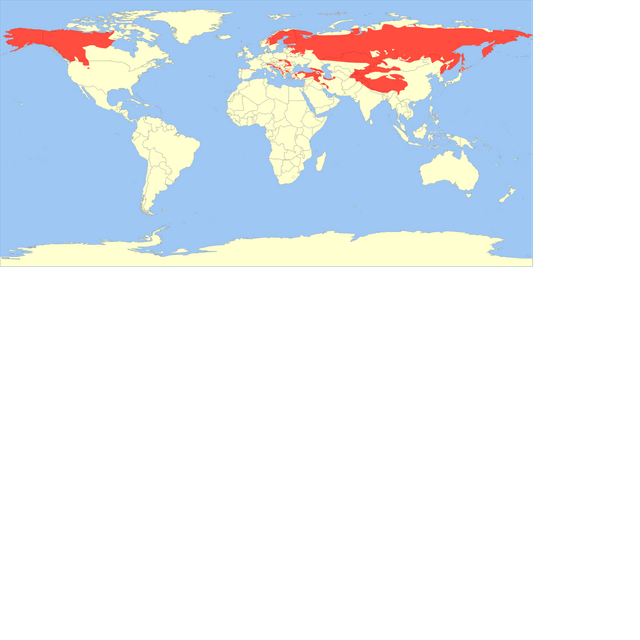
Brown bear

| Brown bear | |
|---|---|
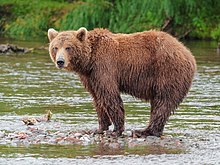 | |
| Kamchatka brown bear at Kamchatka Peninsula, Russia | |
Conservation status | |
| Scientific classification | |
| Kingdom: | Animalia |
| Phylum: | Chordata |
| Class: | Mammalia |
| Order: | Carnivora |
| Family: | Ursidae |
| Genus: | Ursus |
| Species: | U. arctos |
| Binomial name | |
| Ursus arctos Linnaeus, 1758 | |
| Subspecies | |
| 15, see text | |
| Brown bear range map | |
The brown bear (Ursus arctos) is a bear that is found across much of northern Eurasia and North America.[2][1] In North America, the populations of brown bears are often called grizzly bears. It is one of the largest living terrestrial members of the order Carnivora, rivaled in size only by its closest relative, the polar bear (Ursus maritimus), which is much less variable in size and slightly larger on average.[3][4][5][6][7]
The brown bear's principal range includes parts of Russia, Central Asia, China, Canada, the United States, Hokkaido, Scandinavia, and the Carpathian region, especially Romania, Anatolia and the Caucasus.[1][8] The brown bear is recognized as a national and state animal in several European countries.[9]
While the brown bear's range has shrunk and it has faced local extinctions, it remains listed as a least concern species by the International Union for Conservation of Nature (IUCN) with a total population of approximately 200,000. As of 2012, this and the American black bear are the only bear species not classified as threatened by the IUCN.[1][2][10] However, the California grizzly bear, Atlas bear and Mexican grizzly bear were hunted to extinction in the 19th and early 20th centuries and many of the southern Asian subspecies are highly endangered.[1][7] One of the smaller-bodied subspecies, the Himalayan brown bear, is critically endangered, occupying only 2% of its former range and threatened by uncontrolled poaching for its body parts.[11] The Marsican brown bear of central Italy is one of several currently isolated populations of the Eurasian brown bear, and believed to have a population of just 40 to 50 bears.[9][12]
| Brown bear | |
|---|---|
 | |
| Kamchatka brown bear at Kamchatka Peninsula, Russia | |
Conservation status | |
| Scientific classification | |
| Kingdom: | Animalia |
| Phylum: | Chordata |
| Class: | Mammalia |
| Order: | Carnivora |
| Family: | Ursidae |
| Genus: | Ursus |
| Species: | U. arctos |
| Binomial name | |
| Ursus arctos Linnaeus, 1758 | |
| Subspecies | |
| 15, see text | |
| Brown bear range map | |
Evolution and taxonomic history
The brown bear is sometimes referred to as the bruin, from Middle English. This name originated in the fable, History of Reynard the Fox, translated by William Caxton, from Middle Dutch bruun or bruyn, meaning brown (the color).[13] In the mid-19th century United States, the brown bear was termed "Old Ephraim" and sometimes as "Moccasin Joe".[14]
Generalized brown bear names and evolution
Brown bears are thought to have evolved from Ursus etruscus in Asia.[17][18] The brown bear, per Kurten (1976), has been stated as "clearly derived from the Asian population of Ursus savini about 800,000 years ago; spread into Europe, to the New World."[19] A genetic analysis indicated that the brown bear lineage diverged from the cave bear species complex approximately 1.2–1.4 million years ago, but did not clarify if U. savini persisted as a paraspecies for the brown bear before perishing.[20] The oldest fossils positively identified as from this species occur in China from about 0.5 million years ago.[17] Brown bears entered Europe about 250,000 years ago and North Africa shortly after.[17][21] Brown bear remains from the Pleistocene period are common in the British Isles, where it is thought they might have outcompeted cave bears (Ursus spelaeus).[17] The species entered Alaska 100,000 years ago, though they did not move south until 13,000 years ago.[17] It is speculated that brown bears were unable to migrate south until the extinction of the much larger giant short-faced bear (Arctodus simus).[22][23]
Several paleontologists suggest the possibility of two separate brown bear migrations: inland brown bears, also known as grizzlies, are thought to stem from narrow-skulled bears which migrated from northern Siberia to central Alaska and the rest of the continent, while Kodiak bears descend from broad-skulled bears from Kamchatka, which colonized the Alaskan peninsula.[17] Brown bear fossils discovered in Ontario, Ohio, Kentucky and Labrador show the species occurred farther east than indicated in historic records.[17] In North America, two types of the subspecies Ursus arctos horribilis are generally recognized—the coastal brown bear and the inland grizzly bear; these two types broadly define the range of sizes of all brown bear subspecies.[7]
Scientific brown bear taxonomy
There are many methods used by scientists to define bear species and subspecies as no one method is always effective. Brown bear taxonomy and subspecies classification has been described as "formidable and confusing" with few authorities listing the same specific set of subspecies.[24] Genetic testing is now perhaps the most important way to scientifically define brown bear relationships and names. Generally genetic testing uses the word clade rather than species because a genetic test alone cannot define a biological species. Most genetic studies report on how closely related the bears are (or their genetic distance). There are hundreds of obsolete brown bear subspecies, each with its own name, and this can become confusing; Hall (1981) lists 86 different types and even as many as 90 have been proposed.[25][26] However, recent DNA analysis has identified as few as five main clades which contain all extant brown bears,[27][28] while a 2017 phylogenetic study revealed nine clades, including one representing polar bears.[29] As of 2005, 15 extant or recently extinct subspecies were recognized by the general scientific community.[30][31]
As well as the exact number of overall brown bear subspecies, its precise relationship to the polar bear also remains in debate. The polar bear is a recent offshoot of the brown bear. The point at which the polar bear diverged from the brown bear is unclear, with estimations based on genetics and fossils ranging from 400,000 to 70,000 years ago, but most recent analysis has indicated that the polar bear split somewhere between 250,000 and 130,000 years ago.[32] Under some definitions, the brown bear can be construed as the paraspecies for the polar bear.[33][34][35]
DNA analysis shows that, apart from recent human-caused population fragmentation,[36] brown bears in North America are generally part of a single interconnected population system, with the exception of the population (or subspecies) in the Kodiak Archipelago, which has probably been isolated since the end of the last Ice Age.[37][38] These data demonstrate that U. a. gyas, U. a. horribilis, U. a. sitkensis and U. a. stikeenensis are not distinct or cohesive groups, and would more accurately be described as ecotypes. For example, brown bears in any particular region of the Alaska coast are more closely related to adjacent grizzly bears than to distant populations of brown bears,[39] the morphological distinction seemingly driven by brown bears having access to a rich salmon food source, while grizzly bears live at higher elevation, or further from the coast, where plant material is the base of the diet. The history of the bears of the Alexander Archipelago is unusual in that these island populations carry polar bear DNA, presumably originating from a population of polar bears that was left behind at the end of the Pleistocene, but have since been connected with adjacent mainland populations through movement of males, to the point where their nuclear genomes are now more than 90% of brown bear ancestry.[40]
The subspecies have been listed as follows:[30]
Palearctic realm (Eurasia and North Africa)
| Subspecies name | Image | Distribution | Description/comments |
|---|---|---|---|
| Ursus arctos arctos – Eurasian brown bear | 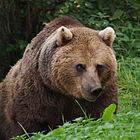 | Represents every population found in Europe as well as their range in western Russia and the Caucasus. May be found as far east in Russia as the Yenisei River in Yamalo-Nenets Autonomous Okrug to Novosibirsk Oblast in the south, where the subspecies intergrades into U. a. collaris.[41] | A predominantly dark, richly brown colored (with rare light-colored individuals), moderately sized subspecies with dark claws, the Eurasian brown bears occurring in Russia are larger than their European counterparts, which may be in part because they are hunted less.[41] |
| Ursus arctos beringianus – Kamchatka brown bear (or Far Eastern brown bear) |  | Found in the coastal lands surrounding the Sea of Okhotsk down as far as the Shantar Islands, Kolyma, all the land around the Shelikhov Gulf, the Kamchatka Peninsula and Paramushir Island.[41] | A very large bear with a broad muzzle. Overall has dark coloring, some animals appearing almost blackish-brown but will usually be paler at the top of the back. It may overlap with U. a. collaris extensively a few miles inland. It is thought to be the ancestor of the polar bear, the Kodiak bear,[17] and the peninsular brown bears of Alaska. Middendorf described it from Greater Shantar Island with its distribution range comprising the eastern coast of Siberia and Japan.[42] |
| Ursus arctos collaris – East Siberian brown bear |  | A majority of Siberia from the Yenisei River to as far south as the Altai Mountains in northern Mongolia, northernmost Xinjiang and northeastern Kazakhstan. Ranges as far north as the southwestern Taymyr Peninsula and the Anabar River. As the farthest east ranging of all Eurasian brown bear populations, it is found in Chukotka as far as the coast of the Bering Strait to the east and the coast of the Chukchi Sea in the north.[41] | Most bears of this type are fairly dark, but some are as pale as grizzly bears. It is intermediate in size between U. a. arctos and U. a. beringianus, with a proportionately larger skull than the nominate subspecies. In the sub-Arctic region of Yakutia, bears are reportedly quite small compared to other regions.[41][43] |
| Ursus arctos crowtheri – †Atlas bear (extinct) |  | Habitat, while still extant, was the Atlas Mountains and adjacent areas in North Africa, from Morocco to Libya. | The last surviving Atlas bear is thought to have been killed by hunters in 1890.[44][45] |
| Ursus arctos isabellinus – Himalayan brown bear |  | Northern Nepal, Northern and Northeastern India and Northern Pakistan, most continuous current range in Jammu and Kashmir. | Quite distinctive physically, as it possess a reddish-brown or sandy-brown coat color with silver-tipped hairs and relatively large ears. This bear is smaller than most other brown bears found on the Asian continent. Prefers high altitude forests and alpine meadows. Critically Endangered. |
| Ursus arctos pruinosus – Tibetan blue bear |  | Tibetan Plateau; some of the bears found in the Himalayas are reportedly actually wandering individuals from the more robustly populated Tibetan subspecies.[41][46] | This is a moderately-sized subspecies with long, shaggy fur. Both dark- and light-colored variants are encountered, with intermediate colors predominating. The fur around the neck, chest and shoulders is yellowish-brown or whitish and frequently forms a collar which no other brown bear subspecies typically possesses in a mature state. Like the Himalayan brown bear, the ears are relatively prominent. The skull is distinguished by its relatively flattened choanae, an arch-like curve of the molar row and large teeth, probably in correlation to its particularly carnivorous habits.[41] |
| Ursus arctos lasiotus – Ussuri brown bear (or Amur brown bear, black grizzly or horse bear) |  | Russia: the southern Kuril Islands, Sakhalin, the Maritime Territory and the Ussuri/Amur River region south of the Stanovoy Range, China (former Manchuria): Heilongjiang, Japan: Hokkaidō, Honshu (in the last glacial period), the Korean Peninsula: North Korea[41] Became extinct on Rebun and Rishiri Islands in the 13th century.[47] | Ursus arctos lasiotus is quite variable in size. Skull dimensions from mainland Russia (i.e. the Primorsky and the Khabarovsk) indicate they can rival Kamchatka brown bears in size.[41][43] By contrast, the population found in Hokkaido is one of the smallest northern forms of the brown bear. Nonetheless, individuals from Hokkaido can reportedly get larger than expected and have reached 400 to 550 kg (880 to 1,210 lb).[48] in weight by feeding on cultivations.[49][50] This bear is thought to be the ancestor of U. a. horribilis.[17] It is perhaps the darkest-colored population on average and some specimens are almost fully black in colour, although lighter brown and intermediate forms are known. Due to its coloring, this subspecies is sometimes informally referred to as the "black grizzly".[41] |
| Ursus arctos syriacus – Syrian brown bear | 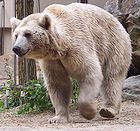 | Transcaucasia, Iraq, Turkey (Asia Minor), Iran, western Afghanistan, eastern Lebanon, Pakistan, western Himalayas and the Pamir-Alay and Tien Shan mountains.[41] Despite a historical presence in Israel and the Syrian Arab Republic (the subspecies' namesake), it is believed to be extinct in these countries now.[1] | The Syrian brown bear is a moderate- to small-sized subspecies with light claws. This population tends to be a whitish-blond color with less noticeable black-based hairs than grizzly bears have.[41] |
| Ursus arctos priscus – Steppe brown bear (extinct) | Unavailable | Eurasia | The steppe brown bear was a extinct prehistoric brown bear subspecies that lived in places like Slovakia. |
Nearctic realm (North America)
| Subspecies name | Image | Distribution | Description/comments |
|---|---|---|---|
| Ursus arctos californicus – †California grizzly bear (extinct) | 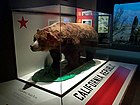 | California, mainly in the Sierra Nevadas and some areas of coastal California. | The last known California grizzly bear was shot in California in 1922. Museum specimens illustrate that this population was golden-blonde overall typically without the contrasting black fur base of true grizzly bears. It also appeared to have been considerably larger, with a broader muzzle than true grizzly bears.[51] |
| Ursus arctos dalli – Dall Island brown bear | Dall Island, Alaska. | Poorly described; possibly merely a coastal variation of other North American brown bears, but any such alliance is genetically ambiguous.[52][53] | |
| Ursus arctos gyas – Alaska Peninsula brown bear |  | Coastal Alaska from the Aleutian Islands as far west as Unimak, the Alaska Peninsula to the Kenai Peninsula. | Considered by some biologists to be the same subspecies as U. a. middendorffi.[54] Based on known size of adult males, if it is a true subspecies, it may match or exceed the Kodiak bear in size.[55][56] |
| Ursus arctos horribilis – Grizzly bear |  | Most of Alaska, Yukon, the Northwest Territories, British Columbia, western Alberta, northern Idaho, western Montana, and northwestern Wyoming. | The grizzly bear is identified by a medium to dark brown coat with gray or blond "grizzled" tips on the fur, which contrast with the black base. Highly variable in size, based largely on environmental conditions.[57] It is also highly adaptable: it can live in montane pine forests, temperate rainforest, semi-arid scrubland, tundra and shortgrass prairie.[58] |
| Ursus arctos middendorffi – Kodiak bear |  | Kodiak, Afognak and Shuyak Islands (Alaska), arguably includes other coastal Alaskan forms, which occur in most of the coasts of the western and southern parts of the state. | This is the largest distinct subspecies of the brown bear, though the coastal-living members of other brown bear subspecies potentially rival it in size. It is medium-hued, typically not as dark as most forms from eastern Asia, but distinctly darker than grizzly bears. |
| Ursus arctos sitkensis – Sitka brown bear |  | Admiralty Island, Baranof Island and Chichagof Island, the "ABC Islands" of Alaska. | Appearing to be more closely related to the polar bear than to other brown bears, although it is on average the most dark-colored population in North America, with similar body size to grizzly bears from interior Alaska.[38][53] This subspecies is called "clade II" by Waits and others and is part of the former subspecies identified as U. a. sitkensis by Hall and as U. a. dalli by Kurtén. |
| Ursus arctos stikeenensis – Stickeen brown bear | Northwestern British Columbia[59] from the Stikine River to the Skeena River.[60] | Variously recognised as a distinct subspecies[30][59] or as belonging to the subspecies U. a. horribilis.[38][51] Larger than most other grizzly bear populations, with males approaching the great bears of coastal Alaska in size.[61][62] | |
| Ursus arctos (Ungava population) – †Ungava brown bear (extinct) | 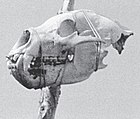 | Northern Quebec and Labrador[63] | Historical reports of brown bears in Quebec were typically dismissed by modern biologists. In 1975, anthropologist Steven Cox discovered a brown bear skull in Labrador, confirming that the population did once exist.[64] |
Hybrids
A grizzly–polar bear hybrid (known either as a pizzly bear or a grolar bear) is a rare ursid hybrid resulting from a crossbreeding of a brown bear and a polar bear. It has occurred both in captivity and in the wild. In 2006, the occurrence of this hybrid in nature was confirmed by testing the DNA of a strange-looking bear that had been shot in the Canadian Arctic, and seven more hybrids have since been confirmed in the same region, all descended from a single female polar bear.[65] Previously, the hybrid had been produced in zoos and was considered a "cryptid" (a hypothesized animal for which there is no scientific proof of existence in the wild).
Formerly considered subspecies
| Former subspecies name | Image | Distribution | Description |
|---|---|---|---|
| Ursus arctos gobiensis – Gobi bear | 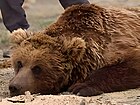 | Gobi Desert | An extremely rare bear found in the Gobi Desert, this bear is adapted to desert life, dwelling in oases and rocky outcrops. It is rather small and pale and it appears to lack the whitish collar characteristic of Tibetan blue bears.[69][70] Phylogenetic analysis suggests they represent a relict population of the Himalayan brown bear.[71][29] At one time, Gobi bears probably overlapped and possibly interbred with Tibetan blue bears in western China, but the bears are now extinct in this area.[72] |
| Ursus arctos marsicanus – Marsican brown bear or Apennine brown bear[73] |  | Marsica, central Italy | There are an estimated 40 to 50 bears remaining in the Marsican area. This is an unrecognized subspecies that is now considered to be a population of the nominate subspecies.[30] |
| Ursus arctos nelsoni – †Mexican grizzly bear (extinct) |  | The smallest North American brown bear, formerly from northern Mexico, including Chihuahua, Coahuila and Sonora and southwestern United States, including the southern regions of Arizona, New Mexico and Texas | This bear is believed to have been hunted to extinction due to its interference with cattle ranching in both the United States and Mexico. Scarce by the 1930s, the last recorded sighting was in 1962.[74] Distinct in its ability to survive arid conditions, it could live in both montane pine forests of Mexico and canyonlands adjacent to the Sonoran Desert. |
| Ursus arctos pyrenaicus – Cantabrian brown bear or Iberian brown bear, now considered to be the same subspecies as the Eurasian brown bear (Ursus arctos arctos) | See photographs in Eroski article (in [485] Spanish, also available in Catalan, Basque and Galician) and in Fauna Ibérica. Oso pardo ibérico (Ursus arctos pyrenaicus), in [486] Spanish | Iberian Peninsula, primarily the Cantabrian Mountains and hills in Galicia, and the Pyrenees.[75] Rare, sporadic sightings in northern Portugal.[76] | Until recently, this bear was considered a separate subspecies. Today, it is considered to belong to the subspecies U. a. arctos. Scientific evidence based on DNA studies would furthermore indicate the Eurasian brown bear can be divided into two distinct lineages. "There is a clear division into two main mitochondrial lineages in modern Eurasian brown bear populations. These populations are divided into those carrying an eastern lineage (clade IIIa, Leonard et al. 2000), which is composed of Russian, northern Scandinavian and eastern European populations, and those carrying a western lineage (clade I, Leonard et al. 2000), which is composed of two subgroups, one believed to originate from the Iberian Peninsula, including southern Scandinavian bears and the Pyrenean populations; and the other from the Italian–Balkan peninsulas (Taberlet et al. 1994; see however Kohn et al. 1995). In addition, based on the subfossil record in northwestern Moldova and mitochondrial DNA data from modern populations, a Carpathian refuge has also been proposed (Sommer & Benecke 2005; Saarma et al. 2007)."[77]The Cantabrian brown bear is the largest wild animal on the Iberian Peninsula, although it is also one of the smallest of the brown bears, weighing between 92 and 180 kg (203 and 397 lb) as an adult.[78] Its fur varies from pale cream to dark brown, but always with a distinctively darker, nearly black tone at the paws and a yellowish tinge at the tip of each hair. The Cantabrian brown bear population in Spain is considered endangered. The Cantabrian brown bear population in the Pyrenees stems mostly from bears reintroduced from Slovenia, with one or two remaining original males.[75][77][79][80][81] |
Description
Color of brown bears
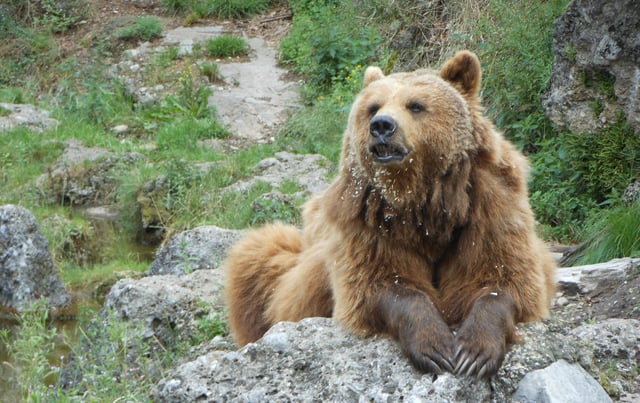
Brown bear on a rock
Brown bears are often not fully brown.[82] They have long, thick fur, with a moderately long mane at the back of the neck which varies somewhat across the types.[83] In India, brown bears can be reddish with silver-tipped hairs, while in China brown bears are bicolored, with a yellowish-brown or whitish collar across the neck, chest and shoulders.[82][84] Even within well-defined subspecies, individuals may show highly variable hues of brown. North American grizzlies can be dark brown (almost black) to cream (almost white) or yellowish-brown and often have darker-colored legs. The common name "grizzly" stems from their typical coloration, with the hairs on their back usually being brownish-black at the base and whitish-cream at the tips, giving them their distinctive "grizzled" color. Apart from the cinnamon subspecies of the American black bear (U. americanus cinnamonum), the brown bear is the only modern bear species to typically appear truly brown.[44] The winter fur is very thick and long, especially in northern subspecies, and can reach 11 to 12 centimetres (4 to 5 in) at the withers. The winter hairs are thin, yet rough to the touch. The summer fur is much shorter and sparser and its length and density varies geographically.[41]
Claws and feet
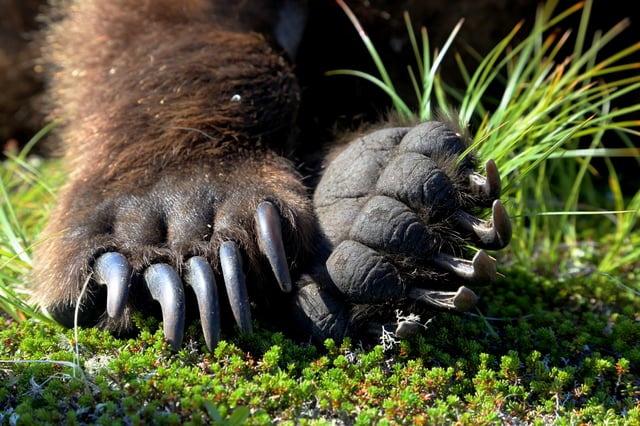
Front paws of a brown bear
Brown bears have very large and curved claws, those present on the forelimbs being longer than those on the hind limbs. They may reach 5 to 6 centimetres (2.0 to 2.4 in) and may measure 7 to 10 centimetres (2.8 to 3.9 in) along the curve.[85] They are generally dark with a light tip, with some forms having completely light claws.[41] Brown bear claws are longer and straighter than those of American black bears (Ursus americanus).[44] The claws are blunt, while those of a black bear are sharp. Due to their claw structure, in addition to their excessive weight, adult brown bears cannot typically climb trees as can both species of black bear, although in rare cases adult female brown bears have been seen in trees.[86] The claws of a polar bear are also quite different, being notably shorter but broader with a strong curve and sharper point, presumably both as an aid to traveling over ice (sometimes nearly vertically) and procuring active prey.[21][87] The paws of the brown bear are quite large. The rear feet of adult bears have been found to typically measure 21 to 36 cm (8.3 to 14.2 in) long, while the forefeet tend to measure about 40% less in length. All four feet in average sized brown bears tend to be about 17.5 to 20 cm (6.9 to 7.9 in) in width. In large coastal or Kodiak bear males, the hindfoot may measure up to 40 cm (16 in) in length, 28.5 cm (11.2 in) in width, while outsized Kodiak bears having had confirmed measurements of up to 46 cm (18 in) along their rear foot.[88][89][90] Brown bears are the only extant bears with a hump at the top of their shoulder, which is made entirely of muscle, this feature having developed presumably for imparting more force in digging, which is habitual during foraging for most bears of the species and also used heavily in den construction prior to hibernation.[44][91]
Cranial morphology and size

Brown bear skull
Adults have massive, heavily built concave skulls, which are large in proportion to the body. The forehead is high and rises steeply.[44] The projections of the skull are well developed when compared to those of Asian black bears (Ursus thibetanus): the latter have sagittal crests not exceeding more than 19–20% of the total length of the skull, while the former have sagittal crests comprising up to 40–41% of the skull's length. Skull projections are more weakly developed in females than in males. The braincase is relatively small and elongated. There is a great deal of geographical variation in the skull, and presents itself chiefly in dimensions.[41] Grizzlies, for example, tend to have flatter profiles than European and coastal American brown bears.[92] Skull lengths of Russian brown bears tend to be 31.5 to 45.5 centimetres (12.4 to 17.9 in) for males, and 27.5 to 39.7 centimetres (10.8 to 15.6 in) for females. The width of the zygomatic arches in males is 17.5 to 27.7 centimetres (6.9 to 11 in), and 14.7 to 24.7 centimetres (5.8 to 9.7 in) in females.[41] Brown bears have very strong teeth: the incisors are relatively big and the canine teeth are large, the lower ones being strongly curved. The first three molars of the upper jaw are underdeveloped and single crowned with one root. The second upper molar is smaller than the others, and is usually absent in adults. It is usually lost at an early age, leaving no trace of the alveolus in the jaw. The first three molars of the lower jaw are very weak, and are often lost at an early age.[41] The teeth of brown bears reflect their dietary plasticity and are broadly similar to other bears, excluding the two most herbivorous living bears, the giant panda (Ailuropoda melanoleuca) and the spectacled bear (Tremarctos ornatus), which have blunt, small premolars (ideal for grinding down fibrous plants) compared to the jagged premolars of ursid bears that at least seasonally often rely on flesh as a food source.[93][94] The teeth are reliably larger than American black bears, but average smaller in molar length than polar bears.[95][96] Brown bears have the broadest skull of any extant ursine bear; only the aforementioned most herbivorous living bears exceed them in relative breadth of the skull.[7][97][98] Another extant ursine bear, the sloth bear (Melursus ursinus), has a proportionately longer skull than the brown bear and can match the skull length of even large brown bear subtypes, presumably as an aid for foraging heavily on insect colonies for which a long muzzle is helpful as an evolved feature in several unrelated mammalian groups.[44][98]
Body size
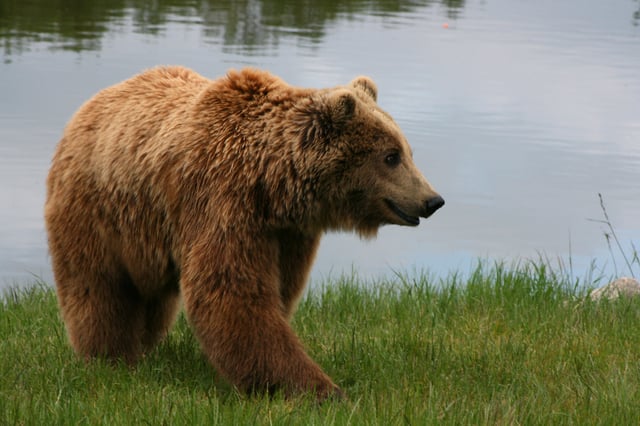
Brown bears are highly variable in size. Eurasian brown bears often fall around the middle to low sizes for the species.
The brown bear is the most variable in size of modern bears. The typical size depends upon which population it is from, and most accepted subtypes vary widely in size. This is in part due to sexual dimorphism, as male brown bears average at least 30% larger in most subtypes. Individual bears also vary in size seasonally, weighing the least in spring due to lack of foraging during hibernation, and the most in late fall, after a period of hyperphagia to put on additional weight to prepare for hibernation. Therefore, a bear may need to be weighed in both spring and fall to get an idea of its mean annual weight.[99][100]
The normal range of physical dimensions for a brown bear is a head-and-body length of 1.4 to 2.8 m (4 ft 7 in to 9 ft 2 in) and a shoulder height of 70 to 153 cm (2 ft 4 in to 5 ft 0 in). The tail is relatively short, as in all bears, ranging from 6 to 22 cm (2.4 to 8.7 in) in length.[101][102] The smallest brown bears, females during spring among barren-ground populations, can weigh so little as to roughly match the body mass of males of the smallest living bear species, the sun bear (Helarctos malayanus), while the largest coastal populations attain sizes broadly similar to those of the largest living bear species, the polar bear.[5][7][103] Interior brown bears are generally smaller than is often perceived, being around the same weight as an average lion, at an estimate average of 180 kg (400 lb) in males and 135 kg (298 lb) in females, whereas adults of the coastal populations weigh about twice as much.[7][104] The average weight of adult male bears from 19 populations, from around the world and various subspecies (including both large- and small-bodied subspecies), was found to 217 kg (478 lb) while adult females from 24 populations were found to average 152 kg (335 lb).[7][97][105][106]
Ecotypes or regional populations
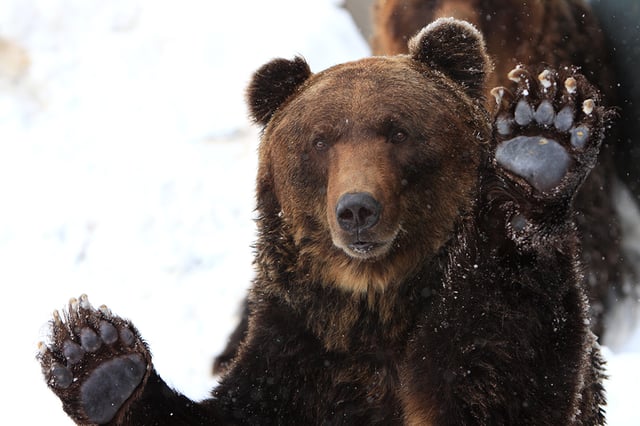
An Ussuri brown bear of Hokkaido, a relatively small-bodied population, in the snow
Brown bear size, most often measured in body mass, is highly variable and is correlated to extent of food access. Therefore, bears who range in ecozones that include have access to openings, cover and moisture or water tend to average larger whereas those bears that range into ecozones with enclosed forested areas or arid, sparsely vegetated regions, both of which tend to be sub-optimal foraging habitat for brown bears, average smaller.[7][97][107] The brown bear in northern Europe (i.e. Scandinavia, eastern Europe, western Russia), Yellowstone National Park or interior Alaska seasonally weigh on average between 115 and 360 kg (254 and 794 lb), from mean low adult female weights in spring to male bear mean high weights in fall. Brown bears from the Yukon Delta, interior British Columbia, Jasper National Park and southern Europe (i.e. Spain, the Balkans) can weigh from 55 to 175 kg (121 to 386 lb) on average.[7][105][108][109][110] These mass variations represent only two widespread subspecies, the grizzly bear in North America and the Eurasian brown bear in Europe. Due to the lack of genetic variation within subspecies, the environmental conditions in a given area likely plays the largest part in such weight variations.[7]
The grizzly is especially variable in size, as grizzlies from the largest populations, i.e. interior Alaska, with the heaviest weights recorded in Nelchina, Alaska, nearly three times heavier in males than the smallest grizzlies from Alberta, Canada's Jasper National Park. Between the sexes, the grizzlies of Nelchina average around 207 kg (456 lb), whereas the Jasper grizzlies averaged about 74 kg (163 lb). The enclosed taiga habitat of Jasper presumably is sub-optimal foraging habitat for grizzlies, requiring them to range widely and feed sparsely, thus reducing body weights and putting bears at risk of starvation, while in surfaces areas in the tundra and prairie are apparently ideal for feeding.[97][111] Even elsewhere in Alberta, weights averaging more than twice those of Jasper grizzlies have been recorded.[112] A gradual diminishment in body size is noted in grizzly bears from the sub-Arctic zone, from the Brooks Range to the Mackenzie Mountains, presumably because food becomes much sparser in such regions, although perhaps the most northerly recorded grizzly bears ever, in the Northwest Territories, was a large and healthy male weighing 320 kg (710 lb), more than twice as much as an average male weighs near the Arctic Circle.[7][97][113] Data from Eurasia similarly indicates a diminished body mass in sub-Arctic brown bears, based on the weights of bears from northern Finland and Yakutia.[43][114][115]
Head-and-body length in grizzly bears averages from 1.8 to 2.13 m (5 ft 11 in to 7 ft 0 in) while in Eurasian brown bears it similarly averages from 1.7 to 2.1 m (5 ft 7 in to 6 ft 11 in).[90][116] Adult shoulder height averaged 95.2 cm (3 ft 1 in) in Yellowstone (for any bear measured five or more years old) and a median of 98.5 cm (3 ft 3 in) (for adults only 10 or more years old) in Slovakia.[117][118] Standing on its hindlegs, a posture only assumed occasionally, typically-sized brown bears can reportedly range from 1.83 to 2.75 m (6 ft 0 in to 9 ft 0 in) in standing height.[119] Exceptionally large inland specimens have been reported in several parts of North America, Europe, Russia and even Hokkaido. The largest recorded grizzlies from Yellowstone and Washington State both weighed approximately 500 kg (1,100 lb) and eastern European bears have been weighed in Slovakia and Bulgaria of up to 400 kg (880 lb), about double the average weight for male bears in these regions.[9][89][117][118] Among the grizzly and Eurasian brown bear subspecies, the largest reportedly shot from each being 680 kg (1,500 lb) and 481 kg (1,060 lb), respectively. The latter bear, from western Russia, reportedly measured just under 2.5 m (8 ft 2 in) in head-and-body length.[89]
In Eurasia, the size of bears roughly increases from the west to the east, with the largest bears there native to eastern Russia.[120] Even in the nominate subspecies size increases in the eastern limits, with mature male bears in Arkhangelsk Oblast and Bashkortostan commonly exceeding 300 kg (660 lb).[121][122] Other bears of intermediate size may occur in inland populations of Russia. Much like the grizzly and Eurasian brown bear, populations of the Ussuri brown bear (U. a. lasiotus) and the East Siberian brown bear (U. a. collaris) may vary widely in size.[41][43] In some cases, the big adult males of these populations may have matched the Kodiak bear in size.[41] East Siberian brown bears from outside the sub-Arctic and mainland Ussuri brown bears average about the same size as the largest-bodied populations of grizzly bear, i.e. those of similar latitude in Alaska, and have been credited with weights ranging from 100 to 400 kg (220 to 880 lb) throughout the seasons.[53][123] On the other hand, the Ussuri brown bears found in the insular population of Hokkaido are usually quite small, usually weighing less than 150 kg (330 lb), exactly half the weight reported for male Ussuri brown bears from Khabarovsk Krai. This is due presumably to the enclosed mixed forest habitat of Hokkaido.[124][125] A similarly diminished size has been reported in East Siberian brown bears from Yakutia, as even adult males average around 145 kg (320 lb), thus about 40% less than the average weight of male bears of this subtype from central Siberia and the Chukchi Peninsula.[43]
In linear measurements and mean body mass, several subspecies may vie for the title of smallest subtype, although thus far their reported body masses broadly overlaps with those of the smaller-bodied populations of Eurasian brown and grizzly bears. Leopold (1959) described the now-extinct Mexican grizzly bear that, according to Rausch (1963), as the smallest subtype of grizzly bear in North America, although the exact parameters of its body size are not known today.[26] Bears from the Syrian subspecies (U. a. syriacus) will reportedly weigh around 100 to 160 kg (220 to 350 lb) in adulthood.[126] The Himalayan brown bear (U. a. isabellinus) is another rival for the smallest subspecies, in Pakistan this subtype averages about 70 kg (150 lb) in females and 135 kg (298 lb) in males.[127] Himalayan brown bear females were cited with an average head-and-body length of merely 1.4 m (4 ft 7 in).[128] Brown bears of the compact Gobi Desert population, which is not usually listed as a distinct subspecies in recent decades, weigh around 90 to 138 kg (198 to 304 lb) between the sexes, so are similar in weight to bears from the Himalayas and even heavier than grizzlies from Jasper National Park. However, the Gobi bear has been reported to measure as small as 1 m (3 ft 3 in) in head-and-body length, which, if accurate, would make them the smallest known brown bear in linear dimensions.[7][70] These smallest brown bear subtypes are characteristically found in "barren-ground" type habitats, i.e. sub-desert in bears from the Syrian subspecies and the Gobi subtype and arid alpine meadow in Himalayan brown bears.[7][70][127]
The largest subspecies are the Kodiak bear (U. a. middendorffi) and the questionably-distinct peninsular or coastal brown bear (U. a. gyas).[7][132][133][133] Also the extinct California grizzly bear (U. a. californicus) was rather large.[26][134] Once mature, the typical female Kodiak bear can range in body mass from 120 to 318 kg (265 to 701 lb) and from sexual maturity onward males range from 168 to 675 kg (370 to 1,488 lb).[7][133][135][136] According to the Guinness Book of World Records the average male Kodiak bear is 2.44 m (8 ft 0 in) in total length (head-to-tail) and has a shoulder height of 1.33 m (4 ft 4 in).[89] When averaged between their spring low and fall high weights from both localities, males from Kodiak island and coastal Alaska weighed from 312 to 389 kg (688 to 858 lb) with a mean body mass of 357 kg (787 lb) while the same figures in females were 202 to 256 kg (445 to 564 lb) with a mean body mass of 224 kg (494 lb).[97][136][137][138][139] By the time they reach or exceed eight to nine years of age, male Kodiak bears tend to be much larger than newly mature six-year-old males, potentially tripling their average weight within three years' time, and can expect to average between 360 and 545 kg (794 and 1,202 lb).[89][90][135] The reported mean adult body masses for both sexes of the polar bear are very similar to the peninsular giant and Kodiak bears. Due to their roughly corresponding body sizes, the two subtypes and the species can both legitimately be considered the largest living member of the bear family Ursidae and largest extant terrestrial carnivores.[89][140][141] The largest widely accepted size for a wild Kodiak bear, as well as for a brown bear, was for a bear killed in English Bay on Kodiak Island in fall 1894 as several measurements were made of this bear, including a body mass of 751 kg (1,656 lb), and a hind foot and a voucher skull were examined and verified by the Guinness Book of World Records.[5][89][142] Claims have been made of larger brown bears, but these appear to be poorly documented and unverified and some, even if recited by reputable authors, may be dubious hunters' claims.[44][143]
The largest variety of brown bear from Eurasia is the Kamchatka brown bear (U. a. beringianus). In the Kamchatka brown bears from past decades, old males have been known to reach body mass of 500–685 kg (1,102–1,510 lb) by fall, putting the subtypes well within Kodiak bear sizes and leading it to be considered the largest of the extant Russian subtypes. However, a diminishment in body size of U. a. berigianus has been noted, mostly likely in correlation with overhunting.[144][145][146] In the 1960s and 1970s, most adult Kamchatka brown bears weighed merely between 150 and 285 kg (331 and 628 lb), however, mean weights of mature male bears have been reported as averaging 350 to 450 kg (770 to 990 lb) in 2005.[123][144][145]
Distribution
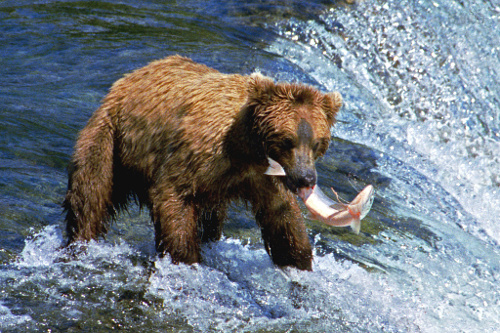
Brown bear at Brooks Falls in Katmai National Park
Brown bears were once native to much of Asia, some parts of the Atlas Mountains of Africa and perhaps most of Europe and North America,[147] but are now extinct in some areas and their populations have greatly decreased in other areas.[2][83] There are approximately 200,000 brown bears left in the world.[148] The largest populations are in Russia with 120,000,[149] the United States with 32,500, Canada with around 25,000 and Romania with around 5,000. The brown bear currently occurs in the countries of Afghanistan, Albania, Andorra (recently reoccupied), Armenia, Azerbaijan, Belarus, Bhutan (possibly extinct), Bosnia and Herzegovina, Bulgaria, Canada, China, Croatia, Czech Republic (possibly only vagrants), Estonia, Finland, France, Georgia, Greece, India, Iran, Iraq, Italy, Japan, Kazakhstan, Kyrgyzstan, Latvia (extinct before World War II; possibly vagrants from Estonia or Russia after World War II), North Macedonia, Mongolia, Montenegro, India, Nepal, North Korea, Norway, Pakistan, Poland, Romania, Russia, Serbia, Slovakia, Slovenia, Spain, Sweden, Tajikistan, Turkey, Turkmenistan, Ukraine, the United States and Uzbekistan.[1]
North America
Canada
As many as 20,000 brown bears range throughout Yukon, the Northwest Territories, British Columbia and in the majority of Alberta. Canada has one of the most stable brown bear populations today. They reach their current eastern limits of their distribution in North America in a majority of Nunavut, northeastern Saskatchewan and northern Manitoba, where they range as far east as the west coast of the Hudson Bay from around Rankin Inlet south to Southern Indian Lake.[1][2][150]
United States

Group of brown bears at Brooks Falls
The brown bear has lost 98% of its habitat in the lower 48 states. About 95% of the brown bear population in the United States is in Alaska, though in the lower 48 states, they are repopulating gradually but steadily along the Rockies and the western Great Plains.[151][152] The Alaskan population is estimated at 32,000 individuals.[153] The largest populations of brown bears in the lower 48 states are found in the 23,300 square kilometre Greater Yellowstone Ecosystem and the 24,800-square kilometre Northern Continental Divide Ecosystem.[154] The Greater Yellowstone Ecosystem of northwest Wyoming is estimated to hold about 674–839 grizzly bears, followed slightly by the Northern Continental Divide Ecosystem of northwest Montana with about 765 animals, the Cabinet-Yaak Ecosystem of northwest Montana and northeast Idaho with about 42–65 animals, the Selkirk Ecosystem of northeast Washington and northwest Idaho with only about 40–50 animals, and (even less) the North Cascades Ecosystem of north-central Washington with about five to 10 animals.[155][156][157][158]
These five ecosystems combine for a total of a maximum 1,729 wild grizzlies still persisting in the contiguous United States. Unfortunately, these populations are isolated from each other, inhibiting any genetic flow between ecosystems and creating low genetic diversity in remaining populations which can have negative long-term effects.[154][159] This isolation poses one of the greatest threats to the future survival of the grizzly bear in the contiguous United States.[154] Although there is no record of their existence in the United States east of the Rocky Mountain and Great Plains regions (except for a relic population in the Ungava Peninsula which survived until the dawn of the 20th century) in human history, fossil records from Kentucky do in fact show that grizzly bears once roamed in eastern North America.[160]
Mexico
Europe

Bear watching hut in Alutaguse, Estonia. There are around 700 bears in Estonia and they are especially numerous in the Alutaguse forests.
Brown bears reach their western limits in Spain. In the Cantabrian Mountains of northwestern Spain, some 210 bears were found to dwell in Asturias, Cantabria, Galicia and León, in the Picos de Europa and adjacent areas in 2013.[163] As of 2015, this population was estimated at around 250 individuals, but only due to it being a more extensive survey and their numbers may be declining rather than increasing.[164] However, the population of brown bears in the Pyrenees Mountains, in a range shared between France, Spain and Andorra, is much lower, estimated at 14 to 25, with a shortage of breeding females.[1][165][166][167] Their rarity in this area has led biologists to release bears, mostly females, from Slovenia in spring 2006 to reduce the imbalance and preserve the species' presence in the area. The bears were released despite protests from French farmers.[168][169] By 2017 the bears in the Pyrenean region had increased to 39, including 10 cubs.[170]
A small population of brown bears (formerly assigned to the subspecies Ursus arctos marsicanus, which is now considered part of the nominate subspecies) still lives in central Italy (the Apennine Mountains, Abruzzo and Latium), with no more than 70 individuals, protected by strong laws, but endangered by the human presence in the area.[73][171]
In eastern and northern Europe, the range of the brown bear currently extends more broadly. Among the most populous countries for brown bears in the eastern region are Romania, which has approximately 4,000–5,000 brown bears, Bulgaria with 900–1,200, Slovakia at about 600–800 bears, Slovenia at approximately 500–700 animals and Greece at about 450[172] animals in the south. The Carpathian brown bear population of Romania is the largest in Europe outside of Russia. Despite the relatively large size of the country's bear population, the species' numbers there were declining alarmingly due to overhunting before Romania's EU membership (which also depended on the protection of the brown bear in the country).[173] Reported annual population growth rates were frequently greater than maximum published growth rates, which could lead to unsustainable hunting.[174] In July 2017, the Romanian Ministry of Environment released an order for the hunting of 175 bears that year because of either the increasing bear population or changes in animal behavior because of destruction of habitat by deforestation, causing an increase in attacks on humans and damage caused by bears to local communities.[175] There is also a smaller brown bear population in the Carpathian Mountains in Ukraine (estimated at about 200 in 2005), Slovakia and Poland (estimated at about 170 in 2009 in the latter country).[176] The total Carpathian population is estimated at about 8,000.[177]
Northern Europe is home to a large brown bear population, with an estimated 2,500 (range 2,350–2,900) in Sweden, about 2,200 in Finland,[178] about 700 in Estonia and 70 in Norway, totaling to nearly 5,000 individuals in the wild. Another large and relatively stable population of brown bears in Europe, consisting of 2,500–3,000 individuals, is the Dinaric-Pindos (Balkans) population, with contiguous distribution in northeast Italy, Slovenia, Croatia, Bosnia and Herzegovina, Serbia, Montenegro, North Macedonia, Albania, Bulgaria and Greece.[179][180] Brown bears inhabited the mountains of Austria until as recently as 2011, after a reintroduction effort failed and the species became extinct again. There is currently no effort to reintroduce the species into Austria.[181] The entire alpine population of brown bears includes about 50 individuals, most of them living in the Adamello Brenta nature park in Italy. Reintroduction of 10 Slovenian brown bears to the Trentino area in 1998 and 2002 produced occasional visitors to the South Tirol, the Swiss Eastern Alps, Bavaria and isolated sightings in the Central Alps. The small group of brown bears living in the Slovenian Alps is connected to the larger Dinaric-Pindos population.[182]
Asia Minor, the Caucasus, the Middle East and Central Asia
In this part of the world, the brown bear occurs from Georgia, Armenia and Azerbaijan southbound spottily through Turkey, northernmost Iraq, western and northern Iran, thence discontinuously in northeastern Kazakhstan, southeastern Uzbekistan and north to Kyrgyzstan. The populations in these countries are generally very small and fragmented, thus they are at high risk of genetic isolation and they occupy only small segments of their former range here.[1][183] At least 20-30 were present in Central Alborz Protected Area in northern Iran as of 2015.[184][185]
South Asia
East Asia
In Asia, brown bears are found in nearly every part of Russia, thence to the southeast in a small area of Northeast China, western China and parts of North Korea. Further west, they reach the southern limits of their worldwide distribution, dwelling spottily in northern Pakistan, Afghanistan and the northern areas of India particularly in Jammu and Kashmir and Himachal Pradesh.[1]
Three distinct lineages of the Hokkaido brown bear (formerly Ursus arctos yesoensis; now considered the same subspecies as the Ussuri brown bear (U. a. lasiotus)) can also be found on the Japanese island of Hokkaido.[189][190] Hokkaido has the largest number of non-Russian brown bears in eastern Asia with about 2,000–3,000 animals,[88] although, in 2015, the Biodiversity Division of the Hokkaido government estimated the population as being as high as 10,600.[191]
Africa north of the Sahara Desert
Many people hold the belief that some brown bears may be present in the Atlas Mountains of Morocco, but there have been none sighted since the 19th century.[192] In addition to the native Atlas bear (U. a. crowtheri), the Romans apparently imported bears from Spain for spectacles with some escaping and founding a population in Africa, though it is doubtful that they still persist today.[28]
Habitat
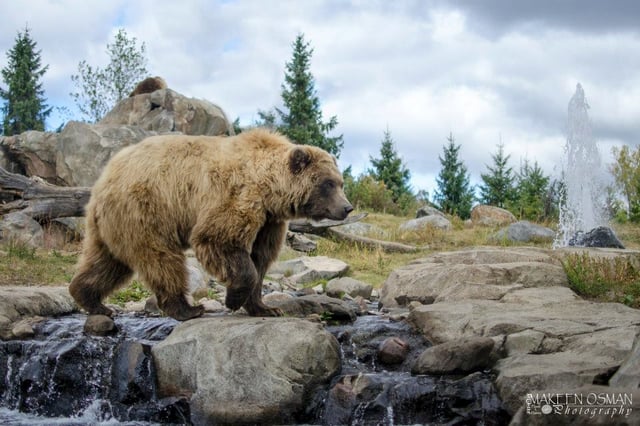
Eurasian brown bears are often adapted to wooded and montane habitats
This species inhabits the broadest range of habitats of any living bear species.[88] They seem to have no altitudinal preferences and have been recorded from sea level to an elevation of 5,000 m (16,000 ft) (the latter in the Himalayas).[88][193] In most of their range, brown bears generally seem to prefer semi-open country, with a scattering of vegetation that can allow them a resting spot during the day. However, they have been recorded as inhabiting every variety of northern temperate forest known to occur.[88] North American brown bears, or grizzly bears, generally seem to prefer open or semi-open landscapes, with the species once having been common on the Great Plains and continue to occur in sizeable numbers in tundra and coastal estuaries and islands. Variable numbers still occur in prairie areas of the northern Rocky Mountains (mostly in Canada, but some in the contiguous United States). Where continuous and protected, such as the Greater Yellowstone Ecosystem, the prairie is near-ideal interior habitat for the species.[21][88]
In western Eurasia, they inhabit mostly mountainous woodlands, in ranges such as the Alps, the Pyrenees and the Caucasus, though they may have been driven into more wooded, precipitous habitats due to the prior extensive persecution of the species in some regions.[143] [194] Desolate parts of northern and eastern Europe, like large patches of Scandinavia and the Carpathian Mountains, have always been quite heavily forested and have maintained relatively stable populations of brown bears, indicating that the bears here are well-adapted to forest-dwelling, although they generally seek foraging opportunities in forest openings such as bogs.[88][195] In general, enclosed forest is sub-standard foraging habitat for brown bears and so they occur irregularly in true taiga lands, despite the boreal forest falling at the middle of their circumpolar distribution.[196]
In Central Asia, human disturbances are minimal as this area has a harsher environment and is more sparsely populated. In this part of the world, bears may be found in steppe, which is sparser and more desert-like than grassland habitats in North America that occur at similar latitudes and some bears may live out their lives even in desert edge, such as those that live in the Middle East (Syrian brown bears) and the rare Gobi bear which is native only to the Chinese-Mongolian desert of its name and isolated from other populations.[83][146][185][197] Alpine meadows are the typical habitat in the Himalayan brown and Tibetan blue subspecies of brown bear.[193][198][199] In Siberia, the species seems well-adapted to living in almost all parts of the extensive pine forests, usually coming to waterways or poorly drained openings and bogs while feeding and sheltering in broad roots and trunks in the interior.[145][146] Eastern Russian forests hold arguably the largest number of brown bears in the world, outside of possibly Alaska and northwestern Canada.[88][146] The brown bears of Hokkaido are also largely forest-dwelling, but dwell in mixed forests dominated by broadleaf trees such as beech.[189][200]
It is thought the Eurasian brown bears which colonized America were tundra-adapted (as many grizzlies are today in North America) and the species is sometimes found around sub-Arctic ice fields. This is indicated by brown bears in the Chukotka Peninsula on the Asian side of the Bering Strait, which are the only Asian brown bears to live year-round in lowland tundra like their North American cousins.[201][202][203] Genetics relay that two separate radiations led to today's North American brown bears, one a coastal form that led to the Kodiak bear (from U. a. beringianus or a common ancestor) and one an interior form that led to the grizzly bear (from U. a. lasiotus or a common ancestor).[17] In Arctic areas, the potential habitat of the brown bear is increasing. The warming of that region has allowed the species to move farther north into what was once exclusively the domain of the polar bear (potentially another offshoot of a radiation of coastal brown bears). In non-Arctic areas, habitat loss is blamed as the leading cause of endangerment, followed by hunting.[204][205][206]
Conservation status
While the brown bear's range has shrunk and it has faced local extinctions, it remains listed as a Least concern species by the IUCN, with a total population of approximately 200,000. As of 2012, this and the American black bear are the only bear species not classified as threatened by the IUCN.[1][2] However, the California grizzly bear, Atlas bear and Mexican grizzly bear, as well as brown bear populations in the Pacific Northwest, were hunted to extinction in the 19th and early 20th centuries and many of the southern Asian subspecies are highly endangered.[51] The Syrian brown bear (Ursus arctos syriacus) is very rare and it has been extirpated from more than half of its historic range.[207] One of the smallest-bodied subspecies, the Himalayan brown bear (Ursus arctos isabellinus), is critically endangered, occupying only 2% of its former range and threatened by uncontrolled poaching for its body parts.[11] The Marsican brown bear in central Italy is believed to have a population of just 30-40 bears.
Regional extinctions
The brown bear is extinct in Algeria, Belgium, Denmark, Egypt, Germany, Hungary, Ireland, Israel, Jordan, Lebanon, Liechtenstein, Lithuania, Luxembourg, Libya, Mexico, Moldova, Monaco, Morocco, the Netherlands, San Marino, Switzerland, Syria, Tunisia and the United Kingdom. It is possibly extinct in Bhutan.[1]
Behavior and life history
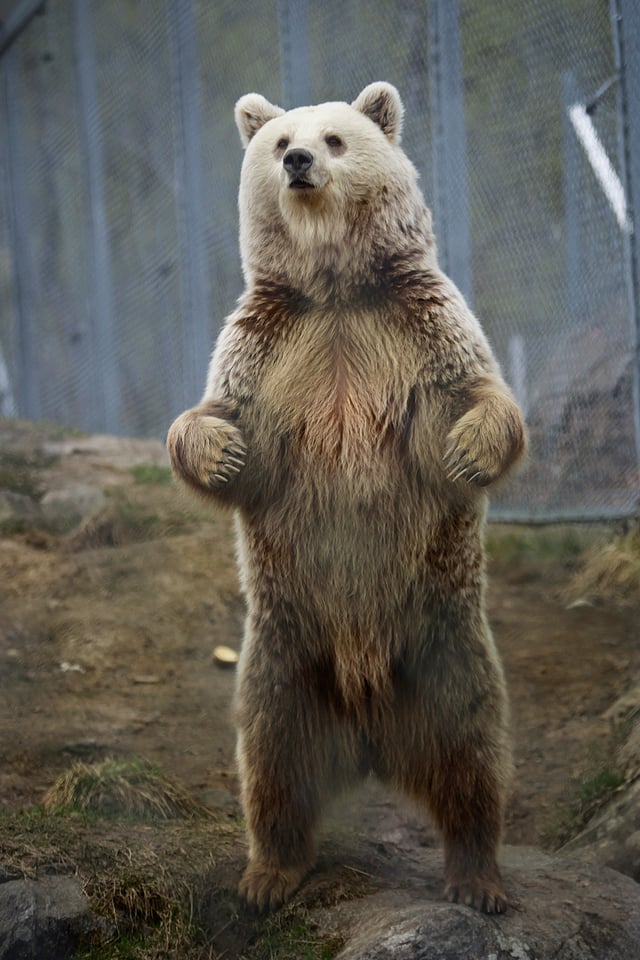
Like all bears, brown bears can stand on their hindlegs and walk for a few steps in this position, usually motivated to do so by curiosity, hunger or alarm
The brown bear is often described as nocturnal. However, it frequently seems to peak in activity in the morning and early evening hours.[208] Studies have shown that activity throughout the range can occur at nearly any time of night or day, with bears who dwell in areas with more extensive human contact being more likely to be fully nocturnal. Furthermore, yearling and newly independent bears are more likely to be active diurnally and many adult bears in low-disturbance areas are largely crepuscular.[209][210][211] In summer through autumn, a brown bear can double its weight from the spring, gaining up to 180 kg (400 lb) of fat, on which it relies to make it through winter, when it becomes very lethargic.[212][213] Although they are not full hibernators and can be woken easily, both sexes like to den in a protected spot during the winter months. Hibernation dens may consist of any spot that provides cover from the elements and that can accommodate their bodies, such as a cave, crevice, cavernous tree roots, or hollow logs.[214][215]
Brown bears have one of the largest brains of any extant carnivoran relative to their body size and have been shown to engage in tool use (e.g., using a barnacle-covered rock to scratch its neck), which requires advanced cognitive abilities.[216] This species is mostly solitary, although bears may gather in large numbers at major food sources (e.g., moth colonies, open garbage dumps or rivers holding spawning salmon) and form social hierarchies based on age and size.[217][218] Adult male bears are particularly aggressive and are avoided by adolescent and subadult males, both at concentrated feeding opportunities and chance encounters. Female bears with cubs rival adult males in aggression and are much more intolerant of other bears than single females. Young adolescent males tend to be least aggressive and have been observed in nonantagonistic interactions with each other.[219][220] Dominance between bears is asserted by making a frontal orientation, showing off canines, muzzle twisting and neck stretching to which a subordinate will respond with a lateral orientation, by turning away and dropping the head and by sitting or lying down.[221] During combat, bears use their paws to strike their opponents in the chest or shoulders and bite the head or neck. In his Great Bear Almanac, Gary Brown lists 11 different sounds bears produce in nine different contexts. Sounds expressing anger or aggravation include growls, roars, woofs, champs and smacks, while sounds expressing nervousness or pain include woofs, grunts and bawls. Sows will bleat or hum when communicating with their cubs.[44]
Home ranges
Brown bears usually occur over vast home ranges; however, they are not highly territorial. Several adult bears often roam freely over the same vicinity without issue, unless rights to a fertile female or food sources are being contested.[7][220] Males always cover more area than females each year. Despite their lack of traditional territorial behavior, adult males can seem to have a "personal zone" in which other bears are not tolerated if they are seen.[222] Males always wander further than females, due to both increasing access to females and food sources, while females are advantaged by smaller territories in part since it decreases the likelihood of encounters with male bears who may endanger their cubs.[7][91][97][223] In areas where food is abundant and concentrated, such as coastal Alaska, home ranges for females are up to 24 km2 (9.3 sq mi) and for males are up to 89 km2 (34 sq mi). Similarly, in British Columbia, bears of the two sexes travel relatively compact home ranges of 115 km2 (44 sq mi) and 318 km2 (123 sq mi). In Yellowstone National Park, home ranges for females are up to 281 km2 (108 sq mi) and up to 874 km2 (337 sq mi) for males. In Romania, the largest home range was recorded for adult males (3,143 km2, 1214 sq mi).[224] In the central Arctic of Canada, where food sources are quite sparse, home ranges range up to 2,434 km2 (940 sq mi) in females and 8,171 km2 (3,155 sq mi) in males.[7][88][91][220]
A study of male-inherited Y chromosome DNA sequence found that brown bears, over the past few 10,000 years, have shown strong male-biased dispersal.[225] That study found surprisingly similar Y chromosomes in brown bear populations as far apart as Norway and coastal Alaska, indicating extensive gene flow across Eurasia and North America. Notably, this contrasts with genetic signals from female-inherited mitochondrial DNA (mtDNA), where brown bears of different geographic regions typically show strong differences in their mtDNA, a result of female philopatry.
Reproduction
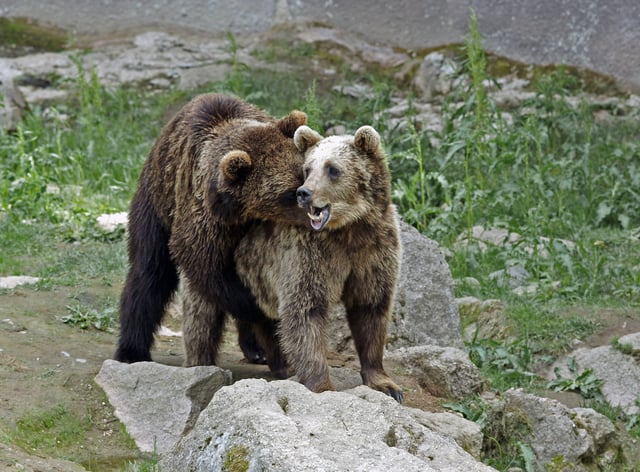
Pair of mating brown bears at the Ähtäri Zoo in Ähtäri, Finland
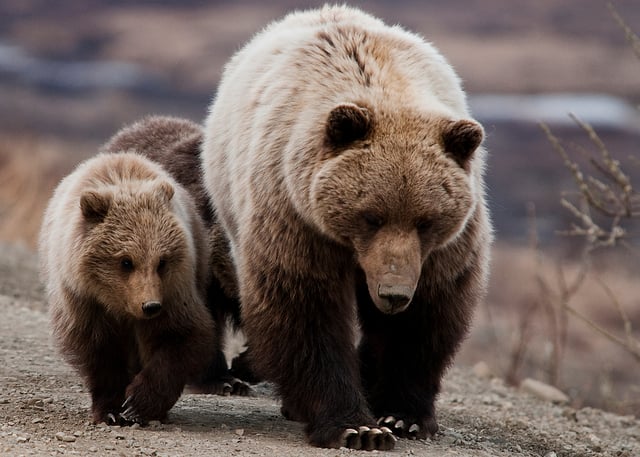
Grizzly bear cubs often imitate their mothers closely

Kodiak bear cubs play-fighting
The mating season is from mid-May to early July, shifting later the further north the bears are found.[88][97][226] Being serially monogamous, brown bears remain with the same mate from a couple of days to a couple of weeks.[7][227] Outside of this narrow time frame, adult male and female brown bears show no sexual interest in each other.[7] Females mature sexually between the age of four and eight years of age, with an average age at sexual maturity of 5.2–5.5 years old, while males first mate about a year later on average, when they are large and strong enough to successfully compete with other males for mating rights.[158][222][228] Males will try to mate with as many females as they can; usually a successful one mates with two females in a span of one to three weeks.[102][228] The adult female brown bear is similarly promiscuous, mating with up to four, rarely even eight, males while in heat and potentially breeding with two males in a single day. Females come into oestrus on average every three to four years, with a full range of 2.4 to 5.7 years. The urine markings of a female in oestrus can attract several males via scent.[91][97][127][223][229] Paternity DNA tests have shown that up to 29% of cubs in a litter will be from two to three different males.[223] Dominant males may try to sequester a female for her entire oestrus period of approximately two weeks, but usually are unable to retain her for the entire time.[97][223] Copulation is vigorous and prolonged and can last up to an hour, although the mean time is about 23–24 minutes.[97][230]
Males take no part in raising their cubs – parenting is left entirely to the females.[220][231] Through the process of delayed implantation, a female's fertilized egg divides and floats freely in the uterus for six months. During winter dormancy, the fetus attaches to the uterine wall. The cubs are born eight weeks later while the mother sleeps. If the mother does not gain enough weight to survive through the winter, the embryo does not implant and is reabsorbed into the body.[158][232][233] There have been cases of brown bears with as many as six cubs, although the average litter size is one to three, with more than four being considered uncommon.[158][234][235] There are records of females sometimes adopting stray cubs or even trading or kidnapping cubs when they emerge from hibernation (a larger female may claim cubs away from a smaller one).[88][236][237] Older and larger females within a population tend to give birth to larger litters[238] The size of a litter also depends on factors such as geographic location and food supply.[239] At birth, the cubs are blind, toothless and hairless and may weigh from 350 to 510 g (0.77 to 1.12 lb), again reportedly based on the age and condition of the mother.[240] They feed on their mother's milk until spring or even early summer, depending on climate conditions. At this time, the cubs weigh 7 to 9 kg (15 to 20 lb) and have developed enough to follow her over long distances and begin to forage for solid food.[116][241]
The cubs are fully dependent on the mother and a close bond is formed. During the dependency stage, the cubs learn (rather than inherit as instincts from birth) survival techniques, such as which foods have the highest nutritional value and where to obtain them; how to hunt, fish and defend themselves; and where to den.[91] Increased brain size in large carnivores has been positively linked to whether a given species is solitary, as is the brown bear, or raises their offspring communally, thus female brown bears have relatively large, well-developed brains, presumably key in teaching behavior.[242] The cubs learn by following and imitating their mother's actions during the period they are with her.[243] Cubs remain with their mother for an average of 2.5 years in North America, uncommonly being independent as early as 1.5 years of age or as late as 4.5 years of age.[97] The stage at which independence is attained may generally be earlier in some parts of Eurasia, as the latest date which mother and cubs were together was 2.3 years, most families separated in under two years in a study from Hokkaido and in Sweden most cubs on their own were still yearlings.[124][244] Brown bears practice infanticide, as an adult male bear may kill the cubs of a female bear.[223] When an adult male brown bear kills a cub, it is usually because he is trying to bring the female into oestrus, as she will enter that state within two to four days after the death of her cubs.[223] Cubs flee up a tree, if available, when they see a strange male bear and the mother often successfully defends them, even though the male may be twice as heavy as she, although females have been known to lose their lives in these confrontations.[245][246][247]
Longevity and mortality
The brown bear has a naturally long life. Wild females have been observed reproducing up to 28 years of age, which is the oldest known age for reproduction of any ursid in the wild. The peak reproductive age for females ranges from four to 20 years old.[88][248] The lifespan of brown bears of both sexes within minimally hunted populations is estimated at an average of 25 years.[249] The oldest wild brown bear on record was nearly 37 years old.[249] The oldest recorded female in captivity was nearly 40 years old, while males in captivity have been verified to live up to 47 years, with one captive male possibly attaining 50 years of age.[7][102]
While male bears potentially live longer in captivity, female grizzly bears have a greater annual survival rate than males within wild populations per a study done in the Greater Yellowstone Ecosystem.[250] Annual mortality for bears of any age is estimated at around 10% in most protected areas;[88] however, the average annual mortality rate rises to an estimated 38% in hunted populations.[88] Around 13% to 44% of cubs die within their first year even in well-protected areas.[7] Mortality rates of 75–100% among the cubs of any given year are not uncommon.[251] Beyond predation by large predators including wolves, Siberian tigers (Panthera tigris altaica) and other brown bears, starvation and accidents also claim the lives of cubs. Studies have indicated that the most prevalent source of mortality for first-year cubs is malnutrition.[7][91][247][252] By the second and third years of their lives, the annual mortality rate among cubs in the care of their mothers drops to 10-15%.[91]
Even in populations living in protected areas, humans are still the leading cause of mortality for brown bears.[2][249][253] The largest amount of legalized brown bear hunting occurs in Canada, Finland, Russia, Slovakia and Alaska.[88] Hunting is unregulated in many areas within the range of the brown bear. Even where hunting is legally permitted, most biologists feel that the numbers hunted are excessive considering the low reproduction rate and sparse distribution of the species.[2][116][251] Brown bears are also killed in collisions with automobiles, which is a significant cause of mortality in the United States and Europe.[254][255]
Dietary habits

Brown bear feeding on salmon
The brown bear is one of the most omnivorous animals in the world and has been recorded consuming the greatest variety of foods of any bear.[88] Throughout life, this species is regularly curious about the potential of eating virtually any organism or object that they encounter. Certainly no other animal in their given ecosystems, short perhaps of other bear species and humans, can claim to feed on as broad a range of dietary opportunities. Food that is both abundant and easily obtained is preferred. Their jaw structure has evolved to fit their dietary habits. Their diet varies enormously throughout their differing areas based on opportunity.[7][249] In spring, winter-provided carrion, grasses, shoots, sedges and forbs are the dietary mainstays for brown bears from almost every part of their distribution.[88] Fruits, including berries, become increasingly important during summer and early autumn. Roots and bulbs become critical in autumn for some inland bear populations if fruit crops are poor.[88] The dietary variability is illustrated in the western United States, as meat made up 51% of the average year-around diet for grizzly bears from Yellowstone National Park, while it made up only 11% of the year-around diet for grizzlies from Glacier National Park a few hundred miles to the north.[111]
Plants and fungi
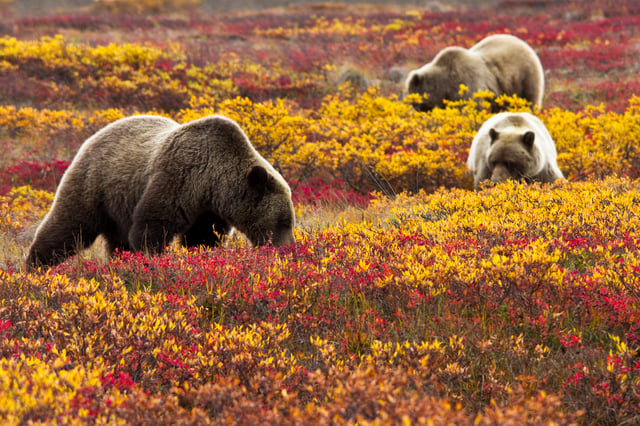
A grizzly bear sow and her two cubs foraging in a field for wild blueberries
Despite their reputation, most brown bears are not highly carnivorous, as they derive up to 90% of their dietary food energy from vegetable matter.[256] Brown bears often feed on a variety of plant life, including berries, grasses, flowers, acorns (Quercus ssp.) and pine cones as well as mosses and fungi such as mushrooms.[7] In total, over 200 plant species have been identified in their foods.[257] Arguably the most herbivorous diets have come from the warmer temperate parts of Eurasia as more than 90% of the diet may be herbivorous. These include countries and regions such as Spain, Slovakia, most of the Balkans including Greece, Turkey, the Himalayas and presumably the Middle East.[117][127][258][259][260] In many inland portions of North America the diet of grizzly bears is between 80 and 90% plant-based, but animal meat can be much more important in some areas.[261][262][263][264] It has been found that being restricted to a largely vegetarian diet puts constraints on the growth and size of bears who live off of them, largely because their digestive systems do not process plants as well as animal fats and proteins.[100][257][265]
Among all living bears, brown bears are uniquely equipped to dig for tough foods, such as roots and shoots. They use their long, strong claws to dig out earth to reach the roots and their powerful jaws to bite through them.[7] For the most part, the consumed plant life in spring, predominantly roots immediately post-hibernation and grasses later in spring, is not highly nutritious for bears and mainly staves off hunger and starvation until more nutritious food is available. Brown bears have difficulty digesting large quantities of tough, fibrous foods.[251][266] Hedysarum roots are among the most commonly eaten foods from throughout the range and can become important substitutes if stable foods such as fruits become unavailable.[263][267] Corms and bulbs are important when available, as they are one of the greater sources of protein in plant life, as are hard masts such as acorns. Brown bears are restricted in their access to hard masts compared to American and Asian black bears because of the limited climbing abilities of grown bears and therefore are confined largely to masts fallen to the ground, pirated from other creatures or within a reach of about 3 m (9 ft 10 in) that the bears can stretch to with their paws extended and standing on their hindlegs.[86] Hard masts can become the most important food (although consumed mainly in late summer and fall) where available in large quantities such as on Hokkaido, Italy and Spain.[251][268][269][270] One of the most important foods in the Rocky Mountains region of the United States is the whitebark pine nut (Pinus albicaulis), which is attained perhaps a majority of the time by raiding the once-abundant caches of American red squirrels (Tamiasciurus hudsonicus) rather than direct foraging.[271] The decline of whitebark pine nuts due to the inadvertent introduction by man of the invasive, virulent fungi Cronartium ribicola has in turn required grizzlies to seek alternative food sources, many of which are carnivorous.[272][273][274] In a Greek food study, soft masts were found to outrank hard masts as a food source, with about a quarter of the year-around diet consisting of the legume Medicago.[258]
Fruits and berries are indispensable for brown bears in most areas as a high-energy food stuff for bears, which is necessary to survive the hibernation cycle. The variety of fruits consumed is high, with most of the well-known, wild fruiting plants in temperate North America and Eurasia attracting brown bears in late summer and fall.[251][275] Among the most prominent fruits found in their foods from through the range include many Prunus species including prunes and cherries, crowberries (Empetrum nigrum), pears (Pyrus ssp.), crabapples (Malus ssp.), brambles (Rubus fruticosus), raspberries (Rubus idaeus), bearberries (Arctostaphylos ssp.) (reportedly named for bears' fondness for them), blueberries (Vaccinium ssp.), lingonberries (Vaccinium vitis-idaea) and huckleberries (Vaccinium parvifolium).[258][261][262][267][276][277] Fruit appears to become more secondary in the diet in areas where hard masts and animal protein are abundant in late summer and fall, as these more protein-rich foods appear to be more nutritious for bears than carbohydrate-rich fruits are, despite their fondness for fruit.[100][260][278] Even where fruit are commonly eaten, other foods must be eaten to meet nutritional requirements. It is estimated that a small female brown bear may need to eat nearly 30,000 berries each day in late summer/fall in order to subsist on a purely fruit-based diet.[100][279]
Invertebrates
Brown bears will also commonly consume animal matter, which in summer and autumn may regularly be in the form of insects, larvae such as grubs and including beehives. Most insects eaten are of the highly social variety found in colonial nests, which provide a likely greater quantity of food, although they will also tear apart rotten logs on the forest floor, turn over rocks or simply dig in soft earth in attempts to consume individual invertebrates such as bugs, beetles and earthworms.[90][128][280] Honey bees and wasps are important supplemental foods in Eurasia from the furthest west of their range, in Spain, to the furthest east, in Hokkaido.[260][268] Bears in Yellowstone and Montana eat an enormous number of moths during the summer, sometimes consuming as many as 40,000 army cutworm moths (Euxoa auxiliaris) in a single day, and may derive up to half of their annual food energy from these insects.[281][282][283] In Europe, a variety of species of ants have been found to factor heavily into the diet in some areas such as Scandinavia and eastern Europe. In Slovenia, for example, up to 25% of the dry mass consumed by brown bears was ants.[284][285] Locally heavy consumption of ants has been reported in North America as well, as in west-central Alberta, 49% of scat contained ants.[286] Brown bears mainly feed on ants with a passive response to the colony being dug out and low levels of formic acid, therefore carpenter ants (Camponotus ssp.), which are accessed through rotten logs rather than underground colonies, are preferred where available.[284] Other important insect aggregations that brown bears feed heavily on in some regions include ladybird beetles and caddisfly.[275] Brown bears living near coastal regions will regularly eat crabs and clams. In Alaska's Katmai National Park and Preserve, brown bears along the beaches of estuaries regularly dig through the sand for soft-shell clam (Mya arenaria) and Pacific razor clam (Siliqua patula), providing a more nutritious source of dietary energy in spring than plant life before fish become available there.[44][287] The zarigani (Cambaroides japonicus), a type of crayfish, of Hokkaido is also an important, protein-rich dietary supplement for brown bears there.[268]
Fish
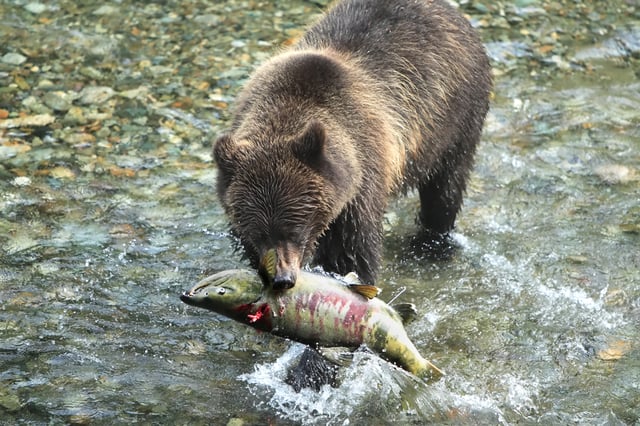
A freshly-caught salmon is a very nutritious meal for a young Alaska Peninsula brown bear
By far the closest dietary relationship between brown bears and fish occurs between the salmon and trout of the genus Oncorhynchus, particularly in coastal areas, but also in some inland areas of North America.[107] In the Kamchatka peninsula and several parts of coastal Alaska, including Kodiak Island, brown bears feed largely on spawning salmon, whose nutrition and abundance explain the enormous size of the bears in these areas.[107][288] Sockeye salmon (O. nerka) and pink salmon (O. gorbuscha) are the two most commonly preyed upon, but many coho (O. kisutch), Chinook (O. tshawytscha), masu (O. masou) and chum salmon (O. keta) are also taken.[289][290][291][292][293] Even in the coastal ranges of the Pacific, a diverse omnivorous diet is eaten, with the salmon spawning reliably providing food only in late summer and early fall. Exceptionally, salmon may come to inland rivers as early as June in the Brooks River when other coastal Alaskan bears are in their dietary "lean period" and provide food for bears sooner than normal.[145] On Kodiak island, it appears the availability of alternative food sources is high, as berry crops are often profuse, marine organisms often wash up and ungulates both wild and domesticated are available.[135][294] The fishing techniques of bears are well-documented. They often congregate around falls when the salmon are forced to breach the water, at which point the bears will try to catch the fish in mid-air (often with their mouths). They will also wade into shallow waters, hoping to pin a slippery salmon with their claws.[107][295] While they may eat almost all the parts of the fish, bears at the peak of spawning, when there is usually a glut of fish to feed on, may eat only the most nutritious parts of the salmon (including the eggs (if the salmon is female) and the head) and then indifferently leave the rest of the carcass to scavengers, which can include red foxes (Vulpes vulpes), bald eagles (Haliaeetus leucocephalus), common ravens (Corvus corax) and gulls.[291] Despite their normally solitary habits, brown bears will gather rather closely in numbers at good spawning sites. The largest and most powerful males claim the most fruitful fishing spots and bears (especially males) will sometimes fight over the rights to a prime fishing spot.[44][296] Despite their aggressive defensive abilities, female brown bears usually select sub-optimal fishing spots to avoid male bears that could potentially threaten their cubs.[297]
One other key relationship occurs between brown bears and Oncorhynchus species occurs with the grizzly bear and the cutthroat trout (O. clarki) in the Rockies such as around Yellowstone. Here this species was consumed in considerable numbers although, like the whitebark pine nut, this food source has declined due to invasive species introduced by man, i.e. invasive trout species which are outcompeting cutthroat trout.[298][299][300][301] The now-extinct California grizzly bear was also a fairly specialized Onocorhynchus predator in California's mountain streams and rivers, principally of rainbow trout (O. mykiss).[26] Outside of Pacific-based salmonids, predatory relationships between brown bears and fish are uncommon. Predation on broad whitefish (Coregonus nasus) and longnose suckers (Catostomus catostomus) has been reported in sub-Arctic Canada and northern pike (Esox lucius) and grayling (Thymallus thymallus) in Siberia, plus other older records of brown bears hunting miscellaneous freshwater fish in Eurasia.[302][303]
Mammals

An Arctic ground squirrel burrow that has been excavated by a hunting barren-ground grizzly bear
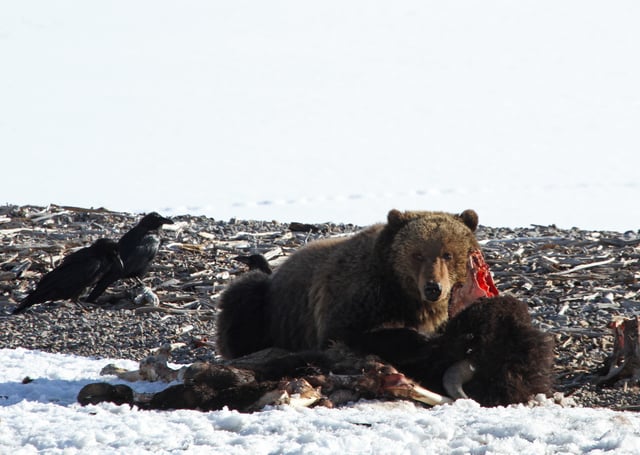
A grizzly bear feasts on a bison carcass in Yellowstone
Beyond the regular predation of salmon, most brown bears are not particularly active predators.[44] Nonetheless, brown bears are capable of obtaining practically all forms of the mammals that they encounter: from mouse-like rodents to those as fearsome as a tiger or as large as a bison.[304][305] Over 100 species of mammal have been recorded either in the scats of brown bears or have been observed as being killed or consumed by the species, although much of this consumption probably represents merely scavenging on carrion.[7][306]
A perhaps surprisingly high balance of mammalian foods consists of rodents or similar smallish mammals, as about half of the species consumed by brown bears weigh less than 10 kg (22 lb) on average. These may include hares (Lepus ssp.), pikas (Ochotona ssp.), marmots (Marmota ssp.), ground squirrels, chipmunks, mice, rats, lemmings and voles. Due to their propensity for digging, brown bears are able to smell out active subterranean burrows of these small mammals and either wait quietly or furiously dig away until the animals are either displaced and lunged at or are cornered in their burrows. Given that most small burrowing mammals found in cool temperate zones enter hibernation, they may be eaten most often when the brown bears exit hibernation earlier, as befits their larger size, allowing them to catch animals in torpor that may otherwise be too agile.[7][44][303] Not only do they consume the small mammals, but they also feed on their caches, as has been recorded in grizzly bears attacking voles and northern pocket gophers (Thomomys talpoides).[307][308] In some areas, caches may be the primary target when bears dig at these animal's burrows, as may be the case with Siberian chipmunks (Eutamias sibiricus), whose hoards can contain up to 20 kg (44 lb) of food, with the chipmunks themselves only being caught occasionally.[86] With particular regularity, tundra-dwelling grizzlies will wait at burrows of Arctic ground squirrels (Spermophilus parryii) hoping to pick off a few of the 750 g (2 lb) rodents. Ground squirrel hunting is most successful in September and October, when early snow may impede the rodents' rocky escape routes. In Denali National Park, Arctic ground squirrels represent about 8% of the year-round diet of grizzly bears and are the most consistent source of animal protein for grizzlies there.[222][261][309] An even more important dietary relationship with a small mammal occurs in the Tibetan blue bear, which is apparently the most completely carnivorous brown bear type, foraging most regularly for plateau pikas (Ochotona curzoniae), a species about one-sixth the weight of an Arctic ground squirrel.[310] As many as 25 pikas have been found in a single bear's stomach and in Changtang, 60% of the diet consisted of pikas.[311] Where plateau pikas are absent, as in the Mustang region of Nepal, Himalayan marmots (Marmota himalayana) become the dietary staple of the bear, occurring in about half of nearly 1,000 scats.[199] Large rodents such as beavers (Castor spp.) and North American porcupines (Erethizon dorsatum) are rare prey items, mostly due to differing habitat preferences, as well as the obvious defenses of the latter.[261][312][313] Up to five species of cetaceans have been recorded as a food source in the coastal regions of Alaska, the Central Arctic and (formerly) California when beached.[312][314]
In most of their range, brown bears regularly feed on ungulates. In many cases, this important food source is obtained as carrion. Carrion is mostly eaten in spring, when winter snow and ice conditions (including snowslides) and starvation claim many ungulate lives. As carcasses are often solidly frozen when encountered, brown bears may sit on them to thaw them sufficiently for consumption. While perhaps a majority of bears of the species will charge at ungulates at some point in their lives, many predation attempts start with the bear clumsily and half-heartedly pursuing the prey and end with the prey escaping alive.[44] On the other hand, some brown bears are quite self-assured predators who habitually pursue and catch large prey items, mainly ungulates. Such bears are usually taught how to hunt by their mothers from an early age.[44] They are the most regular predator of ungulates among extant bear species.[315] The extent of hunting behavior differs by region. For example, in Slovenia, ungulate meat was four times more likely to be obtained as carrion than through hunting, while on the contrary in east-central Alaska, live hunting of ungulates was four times more likely than scavenging of carrion.[316][317] The extent of carnivory in brown bears has been proven to increase at northern latitudes.[318] When brown bears attack these large animals, they usually target young or infirm ones, as they are easier to catch. Successful hunts usually occur after a short rush and ambush, but they may chase down prey in the open and will try to separate mother and young. Prey is usually killed when the bear grabs the rib cage over the back and delivers a bite to the back of the head, neck, face or nose.[319] The bear may also pin its prey (usually young) to the ground and then immediately tear and eat it alive.[320] Despite being characterized as unskilled predators with minimally-refined hunting skills, most individual bears who are routine ungulate predators have shown the ability to vary their hunting strategy and have hunting success rates comparable to other large, solitary carnivorans.[321][322] Brown bears will on occasion bite or swipe at some prey in order to stun it enough to knock it over for consumption.[143] To pick out young or infirm individuals, bears will charge at herds so the slower-moving and more vulnerable individuals will be made apparent. Brown bears may also ambush young animals by finding them via scent.[7] Despite being characterized as a danger primarily to young, spring neonatal ungulates in the first couple of days of life, when they have undeveloped legs and cannot run at full speed, young ungulates may be pursued well into summer or fall after they have developed running abilities.[323][324] Most attacks on adult ungulates occur when the prey has some variety of physical disadvantage. When emerging from hibernation, brown bears, whose broad paws allow them to walk over most ice and snow, may pursue large prey such as moose, whose hooves cannot support them on encrusted snow.[143] Similarly, predatory attacks on large prey sometimes occur at riverbeds, when it is more difficult for the prey specimen to run away due to muddy or slippery soil.[7] On rare occasions, most importantly when confronting unusually large, fully-grown and dangerous prey, bears kill them by hitting with their powerful forearms, which can break the necks and backs of large creatures such as adult moose and adult bison.[44][325]
The leading ungulate prey for brown bears is normally deer. Up to a dozen species have been eaten by brown bears, but the main prey species are the larger species they encounter: elk (Cervus canadensis), moose (Alces alces) and caribou (Rangifer tarandus). Larger deer are preferred because they tend to be less agile and swift than small or medium-sized deer (although a caribou can handily outpace a grizzly bear in the open), they are found in large quantities in several areas inhabited by brown bears and provide a larger meal per carcass.[7][317] Moose may be preferred where found in large numbers because of their solitary habits and tendency to dwell in wooded areas, both of which makes them easier to ambush.[326] Despite its diminished reputation as a predator, the brown bear is the most dangerous solitary predator of moose, with only packs of wolves a more regular predator; even Siberian tigers take other prey, primarily (elk and boar), in areas where they co-exist with the giant deer.[326][327][328] Brown bears normally avoid the potential risks of hunting large deer, which can potentially fight back but usually escape bears by running, by picking out young calves or sickly adults from deer herds.[7][329] In northeastern Norway, it was found that moose were the most important single food item (present in up to 45% of scats and locally comprising more than 70% of the bear's dietary energy) for local brown bears and several local bears appear to be specialized moose hunters, most often picking off sickly yearling moose and pregnant but healthy cows.[327] In Yellowstone National Park, grizzly bears who derived much of their food energy from ungulates were studied, and 30% of the ungulates consumed were through predation, the remaining amount from scavenging of carcasses. Elk, bison and moose (the three largest native ungulates in the region) each constituted nearly a quarter of the overall ungulate diet. 13% of the total of ungulates actively hunted and killed per that study in Yellowstone were elk calves, while 8% of the actively and successfully hunted prey there were adult cow elk.[330] Despite their lack of preference for smaller deer, other species including red deer (Cervus elaphus), sika deer (Cervus nippon ), axis deer (Axis axis), European roe deer (Capreolus capreolus), Siberian roe deer (Capreolus pygargus), fallow deer (Dama dama), mule deer (Odocoileus hemionus) and white-tailed deer (Odocoileus virginianus) have turned up in their diet.[7][260][323][331][332]
As many as 20 species of bovids are also potential prey, including various sheep, goats, antelope, bison (Bison ssp.) and muskoxen (Ovibos moschatus). Bovids are mostly taken in random encounters when bears come across a vulnerable, usually young or sickly individual, as smaller species are extremely agile (and often live in rocky environments) and larger varieties are potentially dangerous, especially if aware of the bear's presence.[261][333][334] In some parts of eastern Europe and Russia, wild boar (Sus scrofa) may be taken in surprisingly large quantities, considering the mostly herbivorous reputation of bears in these regions. One study from the Amur territory of Russia found that brown bears were actually more prolific killers of wild boars than both tigers and gray wolves, but these results are probably biased due to the scarcity of tigers in the region because of overhunting of the big cat.[7][335][336] In rare cases, brown bears are capable of killing bulls of the largest ungulates in regions they inhabit, reportedly including moose, muskox, wild yak (Bos mutus) and both American and European bison (Bison bison and B. bonasus). Remarkably, such attacks are sometimes carried out by bears that were not particularly large, including interior sow grizzlies or small-bodied bears from the Central Arctic, and some exceptional ungulates taken may be up to two to three times the weight of the attacking bear.[199][305][317][337][338][339][340][341] However, most of the bears who took adult moose in east-central Alaska and Scandinavia were large, mature males.[317][340][342]
Other vertebrates
This species may eat birds and their eggs, including almost entirely ground- or rock-nesting species. Although not typically able to capture a healthy grown bird, eggs, nestlings and fledglings of large bird species can be very attractive to brown bears.[44] Species attacked have ranged can be any size available from Aleutian terns (Onychoprion aleuticus) to trumpeter and whooper swans (Cygnus buccinator and C. cygnus).[343][344] Most recorded avian prey have consisted of geese and sea ducks nesting in the lower Arctic Circle, followed by coveys of galliforms, as these birds place their nests in shallow water and on the ground as well as raise their chicks in such areas, so they are relatively more vulnerable.[303][345][346] Large birds of prey, including sea eagles, gyrfalcons (Falco rusticolus) and golden eagles (Aquila chrysaetos), are sometimes exploited as prey if nesting in rock formations that are accessible on foot, and eagles and falcons may furiously dive at bears near their nests.[347][348] Due to their inhabitance of cooler temperate areas, reptiles and amphibians are rarely a food source and have been verified as prey only in a few cases: frogs in the Italian Alps, rat snakes in Hokkaido, grass lizards in the Amur territory and tortoises in Greece.[86][349][350]
Domestic animal food sources
When forced to live in close proximity with humans and their domesticated animals, bears may potentially prey on any type of domestic animal. Most type of livestock have been domesticated for millennia and have little to no anti-predator defenses. Therefore, brown bears are somewhat more likely to attack healthy adult domestic animals than they are healthy adult wild animals.[351][352][353] Among domestic and farm animals, European cattle (Bos primigenius taurus) are sometimes exploited as prey. Cattle are bitten on the neck, back or head and then the abdominal cavity is opened for eating.[7] In Norway, free-ranging domestic sheep (Ovis aries) are numerous and the local brown bears derive 65–87% of their dietary energy in late summer from sheep. Because of the aforementioned vulnerability, examination of Norwegian sheep remains suggest many of the sheep consumed there are adults that were killed by the bears rather than merely scavenged and thus some local farmers received partial compensation for their stock losses. In nearby northern Sweden, free-ranging sheep are not present and the bear derive their food predominantly from natural sources.[354] Domestic horses (Equus ferus caballus), domestic goats (Capra aegagrus hircus), domestic pigs (Sus scrofa domesticus), domestic chickens (Gallus gallus domesticus) and domestic dogs (Canis lupus familaris) may be opportunistically killed in several parts of the brown bear's range as well.[258][341][355][356] Plants and fruit farmed by humans are readily consumed as well, including corn (Zea mays), wheat (Triticum spp.), apples (Malus pumila), sorghum (Sorghum ssp.), melons and many species of berries.[44][276] They will also feed at domestic bee farms, readily consuming both honey and the contents of the honey bee colony.[44] Human food and trash or refuse is eaten when possible. When an open garbage dump was kept in Yellowstone, brown bears were one of the most voracious and regular scavengers. The dump was closed after both brown and American black bears came to associate humans with food and lost their natural fear of them.[44][357] In other areas, such as Alaska, dumps may continue to be an attractant for brown bears.[358][359]
Enemies and competitors
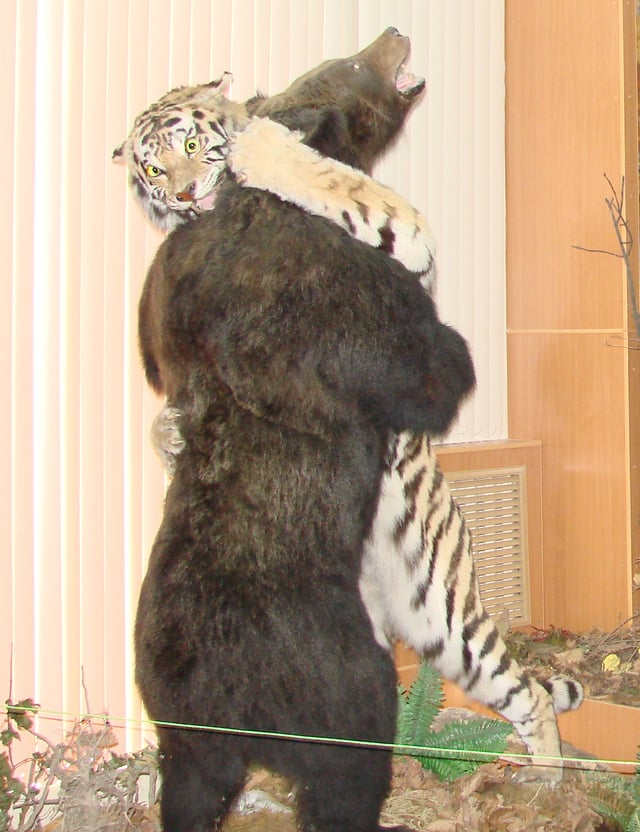
Taxidermy exhibit portraying a brown bear fighting a Siberian tiger, Vladivostok Museum
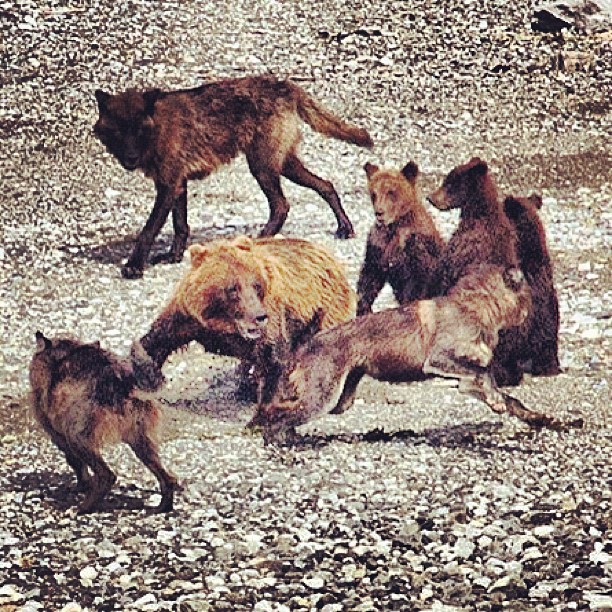
A mother grizzly bear and her cubs threatened by a pack of gray wolves, which reportedly did not or could not harm the cubs in this instance.
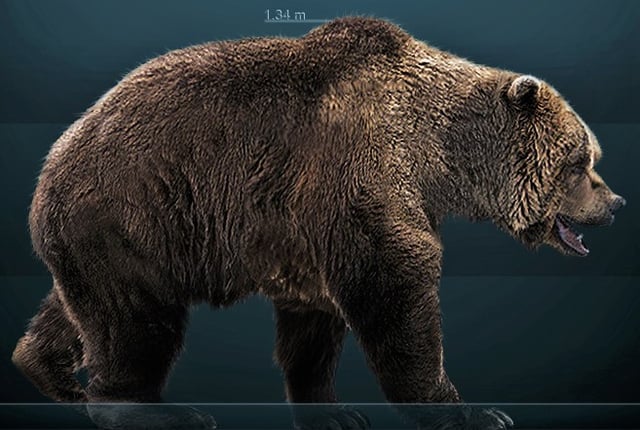
A reconstruction of the cave bear, a close relative of the brown bear that coexisted throughout its evolutionary history
While feeding on carrion, brown bears use their size to intimidate other predators, such as gray wolves (Canis lupus), cougars (Puma concolor), tigers (Panthera tigris) and American black bears (Ursus americanus) from their kills. Owing to their formidable size and aggressive disposition, predation by wild animals outside of their own species is rare for brown bears of any age; even cubs are often safe due to their watchful mother. There are two records of golden eagles (Aquila chrysaetos) preying on brown bear cubs.[360][361]
Adult bears are generally immune to predatory attacks except from tigers and other bears. Siberian tigers (Panthera tigris altaica) prefer preying on young bears but smaller, fully grown adult female brown bears outside their dens may also be taken. Successful predatory attacks by tigers on adult brown bears are usually on females, with or without cubs, in their dens. In the past, exceptionally large male Siberian tigers, such as one weighing approximately 300 kg (660 lb), were reportedly capable of killing even adult male brown bears, but such bears are otherwise more or less safe from attack.[362][363][364][365] Of 44 recorded encounters between tigers and both Asian black and brown bears, 20 resulted in confrontations; in 50% of these, the bears in general (not necessarily brown bears) were killed, in 27% the tigers were killed, and 23% of the cases ended with both animals surviving and parting ways despite injuries sustained in the conflict.[366] Some bears emerging from hibernation seek out tigers in order to steal their kills.[367] Despite the possibility of tiger predation, some large brown bears may actually benefit from the tiger's presence by appropriating tiger kills that the bears may not be able to successfully hunt themselves and follow tiger tracks.[368] Geptner et al. (1972) stated that bears are generally afraid of tigers and change their path after coming across tiger trails.[369] In the winters of 1970–1973, Yudakov and Nikolaev recorded one case of a brown bear showing no fear of the tigers and another case of a brown bear changing its path upon crossing tiger tracks.[370] Other researchers have observed bears following tiger tracks to scavenge tigers' kills or to prey on tigers.[371] Bears frequently track down tigers to usurp their kills, with occasional fatal outcomes for the tiger. A report from 1973 describes 12 known cases of brown bears killing tigers, including adult male tigers; in all cases the tigers were subsequently eaten by the bears.[372][373] There are reports of brown bears specifically targeting Amur leopards and tigers to appropriate their kills. In the Sikhote-Alin Reserve, 35% of tiger kills were stolen by bears, with the tigers either departing entirely or leaving part of the kill for the bear.[304]
Brown bears regularly intimidate gray wolves (Canis lupus) away from their kills, with wolves occurring in most of the brown bear's worldwide distribution.[7] In Yellowstone National Park, brown bears pirate wolf kills so often, Yellowstone's Wolf Project director Doug Smith wrote, "It's not a matter of if the bears will come calling after a kill, but when." Similarly, in Denali National Park, grizzly bears routinely rob wolf packs of their kills.[261] On the contrary, in Katmai National Park and Preserve, wolves, even lone wolves, may manage to displace brown bears at carrion sites.[374] Despite the high animosity between the two species, most confrontations at kill sites or large carcasses end without bloodshed on either side. Although conflict over carcasses is common, on rare occasions the two predators tolerate each other on the same kill. To date, there are only a few cases of fully-grown wolves being killed by brown bears and none of wolves killing healthy adult brown bears.[252][375][376] Given the opportunity, however, both species will prey on the other's cubs.[261][377] Conclusively, the individual power of the bear against the collective strength of the wolf pack usually results in a long battle for kills or domination.
In some areas, the grizzly bear also regularly displaces cougars (Puma concolor) from their kills, with some estimates showing cougars locally lose up to a third of their dietary energy to grizzly bears.[378] Cougars kill small bear cubs on rare occasions, but there was one report of a bear killing a cougar of unknown age and condition between 1993 and 1996.[379][380] Eurasian lynx (Lynx lynx), the largest type of lynx and the only one to regularly take large prey, is similarly an habitual victim of kleptoparasitism to brown bears throughout Eurasia.[381][382] Brown bears also co-exist with leopards (Panthera pardus) (in very small remnant wild parts of the Middle East, Jammu and Kashmir, northeastern China and the Primorsky Krai) and snow leopards (Panthera uncia) in several areas of northern central Asia and the Tibetan Plateau). Although the brown bears' interactions with these big cats are little-known, they probably have similar relationships as grizzly bears do with cougars in North America. Snow leopards and Tibetan blue bears are verified, however, to be a threat to one another's cubs.[1][383][384]
Smaller carnivorous animals are dominated by brown bears and generally avoid direct interactions with them, unless attempting to steal scraps of food. Species which utilize underground or rock dens tend to be more vulnerable to predatory attacks by brown bears. Several mustelids, including badgers, are not infrequently preyed upon and seemingly even arboreal martens may be attacked (especially if unhealthy or caught in furbearer traps).[260][270][306][385] In North America, both species of otter (North American river and sea) have been known to be ambushed by brown bears when on land.[386][387] On the contrary, wolverines (Gulo gulo) are known to have been persistent enough to fend off a grizzly bear as much as 10 times their weight from a kill.[44] In some rare cases, wolverines have lost their lives to grizzly bears and wolverines in Denali National Park will reportedly try to avoid encounters with grizzlies.[261][388] Beyond wolves, other canids may occasionally be killed around their den, most likely pups or kits, or adults if overly incautious near a carrion site, including coyotes (Canis latrans), multiple species of foxes and raccoon dogs (Nyctereutes procyonoides).[86][258][389][390][391] Medium-sized cats may also be rarely killed by brown bears.[392] Seals are on rare occasions killed by brown bears, including eyewitness accounts of Russian bears ambushing spotted (Phoca largha) and harbor seals (Phoca vitulina). Consumption of ringed (Pusa hispida) and bearded seal (Erignathus barbatus) has been reported in the Mackenzie river delta, presumably via predation or scavenging of polar bear kills, as pinnipeds are not usually encountered as carrion from land.[145][312][393]
Brown bears usually dominate other bear species in areas where they coexist. Due to their smaller size, American black bears (Ursus americanus) are at a competitive disadvantage to brown bears in open, unforested areas. Although displacement of American black bears by brown bears has been documented, actual interspecific killing of American black bears by brown bears has only occasionally been reported. Confrontation is mostly avoided due to the American black bear's diurnal habits and preference for heavily forested areas, as opposed to the brown bear's largely nocturnal habits and preference for open spaces. Where they do not live in close proximity to grizzly bears, and especially where found near human habitations, American black bears may become, to a larger extent, nocturnal.[394][395][395][396] Brown bears may also kill Asian black bears, though the latter species probably largely avoids conflicts with the brown bear due to similar habits and habitat preferences to the American black species.[397] Brown bears will eat the fruit dropped from trees by the Asian black bear, as they themselves are too large and cumbersome to climb.[398] Improbably, in the Himalayas, brown bears are reportedly intimidated by Asian black bears in confrontations. However, the Himalayan black bears are reportedly more aggressive towards humans than the Himalayan brown bear, and the latter is one of the smaller types of brown bear, though still somewhat larger than the Asian black bear.[193][399] In Siberia, the opposite is true, and Asian black bears are not known to attack people, but brown bears are.[400] Both species of black bear seem to be most vulnerable to predatory attacks by brown bears when the latter species leaves hibernation sooner in early spring and ambushes the smaller ursids in their dens.[395][397]
There has been a recent increase in interactions between brown bears and polar bears (Ursus maritimus), theorized to be caused by climate change. Brown bears have been seen moving increasingly northward into territories formerly claimed by polar bears. Despite averaging somewhat smaller sizes, brown bears tend to dominate polar bears in disputes over carcasses,[401] and dead polar bear cubs have been found in brown bear dens.[303][402]
Large herbivores, such as moose, bison and muskox may have an intolerance of brown bears due to their possible threat to vulnerable members of their herds or themselves; moose regularly charge grizzly bears in their calf's defense, but seldom are the bears killed.[261][403][404] Bison have been known to fatally injure lone grizzly bears in battles, and even a mountain goat (Oreamnos americanus) was observed to do so with its horns, although herbivores are rarely a serious danger to brown bears.[44]
Paleo-ecology and interactions
In the roughly 0.9 million years of its existence, brown bears have had to contend with multiple competing species, a majority of which went extinct at the end of the Pleistocene Era.[20] In its much longer history in Eurasia, brown bears diverged from the two species of cave bear, the cave bear (U. spelaeus) and the Pleistocene small cave bear (U. rossicus), two species that it existed alongside in what is now Europe for the larger species and Central Asia and Siberia for the smaller species.[405] The cave bears were similar in size to the larger forms of brown bear and polar bear alive today in terms of length, but were bulkier, with much higher-density skeletal remains and presumably rather heavier than the modern brown bear, with the cave bear about the same length as a modern Kodiak bear, but projected to be some 30% heavier.[5][406] Pleistocene-era brown bears appear to have been somewhat larger and more carnivorous than most modern forms based on skull dimensions.[407][408] The cave bears are usually deemed to have been highly herbivorous to a greater extent than the brown bear, based on examinations of stable isotopes and dental morphology.[409][410] Recent studies, however, have shown that cave bears could have opportunistically adapted to a fairly omnivorous diet and consumed many herbivore carcasses.[411] Despite this, the dietary differences and differing habitat preferences (caves, of course, being much more habitually used by the cave bears rather than by the brown bear) allowed the three Ursus to persist at the same time in different parts of Eurasia.[412][413][414]
A more dangerous competitor was encountered by brown bears upon crossing the Bering Land Bridge about 100,000 years ago in the form of the giant short-faced bear (Arctodus simus), a long-legged bear that was estimated to have weighed about twice as much on average than a modern Kodiak bear.[5][415][416] Although at one time deemed a hyper-carnivorous predator that used its long legs to run down large prey, more recent studies have indicated that, like the modern brown bear, it was an omnivorous opportunist that probably scavenged many meals and presumably used its size and great height to intimidate large predators from kills. Until it declined along with its food sources, dwindling into extinction, the giant short-faced bear presumably prevented the brown bear from spreading south, mainly through competition but also, to some extent, predation.[417][418][419][420] A single fossil ulna some 70,000-years-old found in Great Britain, deemed to come from an extremely large sub-adult Pleistocene polar bear (Ursus maritimus tyrannus), was projected to be the largest known form of the genus Ursus. However, this cannot be ruled out as an extinct population of brown bear, based on the inconclusiveness of the only known fossil.[35][421] Other carnivorans during the Pleistocene that, based on their large size, were possibly occasional predators of early brown bears (at least females and cubs), were primarily big cats, including the cave lion (Panthera spelaea) and the saber-toothed cat Machairodus in Eurasia and, perhaps rarely, in southern Beringia (i.e. in northwestern North America) the American lion (Panthera atrox), the saber-toothed cat Smilodon and the scimitar-toothed cat Homotherium. Interactions with these large cats were probably not highly disparate from those that continue today between brown bears and the Siberian tiger.[422][423][424][425] Unlike most of these species, the brown bear was able to survive the Quaternary extinction event that concluded the Ice Age. Presumably, this was due to its greater dietary and habitat plasticity and its adoption of a more extensively herbivorous diet, as most temperate zone herbivores that may have provided meals for more specialized large land carnivores went extinct, as the warming climate killed off their food source.[412][426][427]
It is likely that humans have caused the extinction and fragmentation of bear populations and their habitats since prehistoric times. It has been shown, for instance, that bear populations from the Greater Caucasus and the Lesser Caucasus Mountains, separated by the densely populated Transcaucasian Depression, have been matrilineally isolated since the early Holocene Era, i.e., after permanent human settlements appeared throughout the area.[194] While hunting by early humans was a (previously underestimated) factor in many of the Quaternary extinction events, a perhaps stronger factor in the survival of this species compared to many other northern Pleistocene bears is the brown bear's stronger genetic diversity. In comparison, the cave bear appeared to enter a genetic bottleneck that started a population decline some 25,000 years before the species' extinction.[428][429][430]
Relationship with humans
Conflicts between bears and humans
Brown bears usually avoid areas where extensive development or urbanization has occurred, unlike the smaller, more inoffensive American black bear which can adapt to peri-urban regions.[109][431][432][433] Under many circumstances, extensive human development may cause brown bears to alter their home ranges.[434][435] High road densities (both paved and gravel roads) are often associated with higher mortality, habitat avoidance and lower bear density.[436] However, brown bears can easily lose their natural cautiousness upon being attracted to human-created food sources, such as garbage dumps, litter bins and dumpsters. Brown bears may even venture into human dwellings or barns in search of food as humans encroach into bear habitats.[357][359] In different parts of their distribution, brown bears sometimes kill and eat domesticated animals.[269][352][437] The saying "A fed bear is a dead bear" has come into use to popularize the idea that allowing a bear to scavenge human garbage, such as trash cans and campers' backpacks, pet food, or other food sources that draw the bear into contact with humans, can result in the bear's death.[438] Results of a 2016 study performed in a southeastern British Columbian valley indicate that areas where attractive bear food and concentrated human settlements overlap, human-bear conflict can create an ecological trap resulting in a lower apparent survival rate for brown bears, as well as attracting additional bears and thereby causing overall population declines.[439]
When brown bears come to associate human activity with a "food reward", they are likely to continue to become emboldened; the likelihood of human-bear encounters increases, as they may return to the same location despite relocation. Relocation of the bear has been used to separate the bear from the human environment, but it does not address the problem of the bear's newly-learned association of humans with food or the environmental situations which created the human-habituated bear. "Placing a bear in habitat used by other bears may lead to competition and social conflict, and result in the injury or death of the less dominant bear."[440] Yellowstone National Park, a reserve located in the western United States, contains prime habitat for the grizzly bear (Ursus arctos horribilis) and due to the enormous number of visitors, human-bear encounters are common. The scenic beauty of the area has led to an influx of people moving into the area. In addition, because there are so many bear relocations to the same remote areas of Yellowstone, and because male bears tend to dominate the center of the relocation zone, female bears tend to be pushed to the boundaries of the region and beyond. As a result, a large proportion of repeat offenders, bears that are killed for public safety, are females. This creates a further depressive effect on an already-endangered subspecies. The grizzly bear is officially described as "Threatened" in the U.S.. Although the problem is most significant with regard to grizzlies, these issues affect the other types of brown bears as well.[441][442][443]
In Europe, part of the problem lies with shepherds; over the past two centuries, many sheep and goat herders have gradually abandoned the more traditional practice of using dogs to guard flocks, which have concurrently grown larger. Typically, they allow the herds to graze freely over sizeable tracts of land. As brown bears reclaim parts of their range, they may eat livestock as sheep and goats are relatively easy for a bear to kill. In some cases, the shepherds shoot the bear, thinking their livelihood is under threat. Many are now better informed about the ample compensation available and will make a claim when they lose livestock to a bear.[169][354][444] Another issue in several parts of their range in Europe is supplemental feeding stations where various kind of animal carrion is offered, which are set up mainly in Scandinavia and eastern Europe both to support the locally threatened species and so humans can enjoy watching bears that may otherwise prove evasive. Despite that most stations were cautiously set in remote areas far from human habitations, some brown bears in such areas have become conditioned to associate humans with food and become excessively bold "problem bears". Also, supplemental feeding appears to cause no decrease in livestock predation.[445][446]
Relationship with Native Americans

Gorgonia, a Native American (Mescalero Apache) man. He holds a bear pelt and wears moccasin boots, a breechcloth, kilt, and vest.
Native American tribes sympatric with brown bears often view them with a mixture of awe and fear.[447] North American brown bears have at times been so feared by the Natives that they were rarely hunted by them, especially when alone. At traditional grizzly hunts in some western tribes such as the Gwich’in, the expedition was conducted with the same preparation and ceremoniality as intertribal warfare and was never done except with a company of four to 10 warriors. The tribe members who dealt the killing blow were highly esteemed among their compatriots.[448] Californian Natives actively avoided prime bear habitat and would not allow their young men to hunt alone for fear of bear attacks. During the Spanish colonial period, some tribes, instead of hunting grizzlies themselves, would seek aid from European colonists to deal with problem bears. Many authors in the American West wrote of Natives or voyageurs with lacerated faces and missing noses or eyes, due to attacks from grizzlies.[22][449]
Many Native American tribes both respect and fear the brown bear.[448][449][450] In Kwakiutl mythology, American black and brown bears became enemies when Grizzly Bear Woman killed Black Bear Woman for being lazy. Black Bear Woman's children, in turn, killed Grizzly Bear Woman's own cubs.[451] Sleeping Bear Dunes is named after a Native American legend, where a female bear and her cub swam across Lake Michigan. Exhausted from their journey, the bears rested on the shoreline and fell sound asleep. Over the years, the sand covered them up, creating a huge sand dune.
Bear encounters
There are an average of two fatal attacks by bears per year in North America.[452] In Scandinavia, there are only four known cases since 1902 of bear encounters which have resulted in death. The two most common causes for bear attack are surprise and curiosity.[453] Some types of bears, such as polar bears, are more likely to attack humans when searching for food, while American black bears are much less likely to attack. Despite their boldness and potential for predation if the bear is hungry, polar bears rarely attack humans because they are infrequently encountered in the Arctic sea.[452]
The Alaska Science Center ranks the following as the most likely reasons for bear attacks:[453]
Surprise
Curiosity
Invaded personal space (this includes a mother bear protecting her cubs)
Predatory intent
Hunting wounded
Carcass defense
Provoked charge
Aggressive behavior in brown bears is favored by numerous selection variables. Increased aggressiveness also assists female brown bears in better ensuring the survival of their young to reproductive age.[454] Mothers defending cubs are the most prone to attacking, being responsible for 70% of brown bear-caused human fatalities in North America.[455]
Attacks on humans
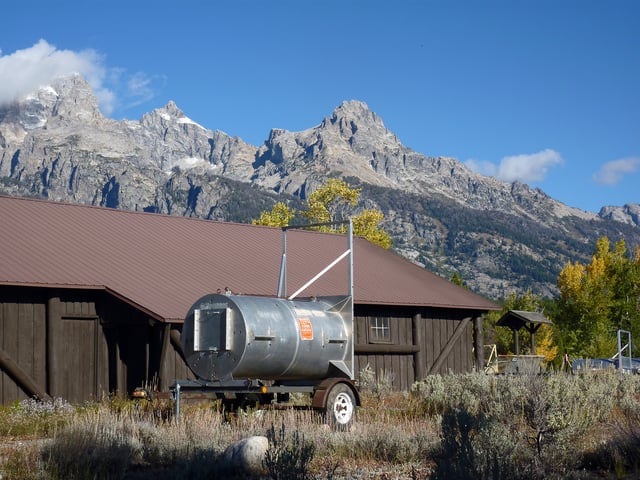
Drum or barrel trap used to safely relocate bears; currently parked adjacent to a building in Grand Teton National Park in Wyoming, United States
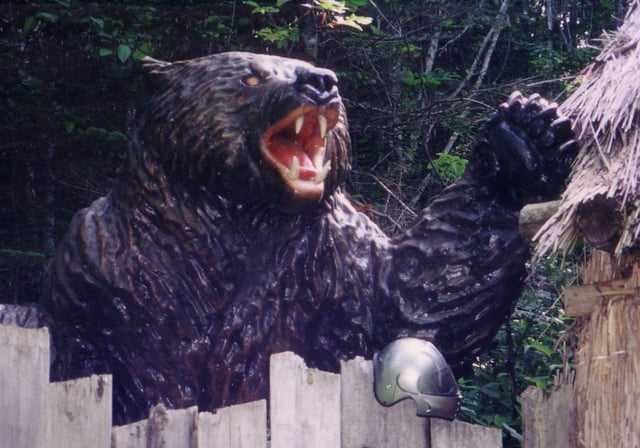
A statue of the Ussuri brown bear from Hokkaido which perpetrated the worst brown bear attack in Japanese history, killing seven people
Brown bears seldom attack humans on sight and usually avoid people. In Russia, it is estimated that one in 1,000 on-foot encounters with brown bears results in an attack.[145] They are, however, unpredictable in temperament, and may attack if they are surprised or feel threatened.[456] Despite the low rate of attack, they appear to be the most dangerous northern carnivoran to humans, attacking more people on average annually than American black bears or northern populations of Asian black bears and Siberian tigers, cougars or gray wolves.[456][457][458][459][460] Several large carnivorans from tropical regions of Africa and Asia may be more dangerous to humans than brown bears, including other ursids such as the sloth bear and Indian populations of the Asian black bear. Each of the latter species of bear may kill up to 12 people annually in certain Indian districts, about as many in a relatively small area as all of the world's brown bears combined. The high levels of human-directed aggression in these ursine bears is reportedly their evolution with once-large numbers of predatory Bengal tigers (arguably itself the world's most dangerous carnivoran to humans, even with its extreme decline in modern times, being statistically much more likely to attack than their northern Siberian cousins) and a very large human population, increasing the risk of surprising and angering a defensive Asian black or sloth bear, the latter species often charging aggressively rather than fleeing if a surprise encounter occurs, as do most other bear species.[102][352][461][462]
Sows with cubs account for many attacks on humans by brown bears in North America. Habituated or food-conditioned bears can also be dangerous, as their long-term exposure to humans causes them to lose their natural shyness and, in some cases, to associate humans with food. Small parties of one or two people are more often attacked by brown bears than large groups, with only one known case of an attack on a group of six or more. In that instance, it is thought that due to surprise, the grizzly bear may not have recognized the size of the group.[463] In the majority of attacks resulting in injury, brown bears precede the attack with a growl or huffing sound.[456] In contrast to injuries caused by American black bears, which are usually minor, brown bear attacks more often tend to result in serious injury and, in some cases, death.[456] Brown bears seem to confront humans as they would when fighting other bears: they rise up on their hind legs, and attempt to "disarm" their victims by biting and holding on to the lower jaw to avoid being bitten in turn.[22] Due to the bears' enormous physical strength, even a single bite or swipe can be deadly as in tigers, with some human victims having had their heads completely crushed by a bear bite.[92][464] Most attacks occur in the months of July, August and September, the time when the number of outdoor recreationalists, such as hikers or hunters, is higher. People who assert their presence through noises tend to be less vulnerable, as they alert bears to their presence. In direct confrontations, people who run are statistically more likely to be attacked than those who stand their ground. Violent encounters with brown bears usually last only a few minutes, though they can be prolonged if the victims fight back.[456] In Alberta, two common behaviors by human hunters, imitating the calls of deer to attract them and carrying ungulate carcasses, seem to court aggressive behavior and lead to a higher rate of attack from grizzly bears.[465]
Attacks on humans are considered extremely rare in the former Soviet Union, though exceptions exist in districts where they are not as often pursued by hunters.[41] East Siberian brown bears, for example, tend to be much bolder toward humans than their shyer, more persecuted European counterparts. The delineation in Eurasia between areas where aggressiveness of brown bears tends to increase is the Ural Mountains, although the brown bears of eastern Europe are somewhat more aggressive than those of western Europe.[249][466] In 2008, a platinum mining compound in the Olyotorsky district of northern Kamchatka was besieged by a group of 30 bears, who killed two guards and prevented workers from leaving their homes.[467] 10 people a year on average are killed by brown bears in Russia, more than all the other parts of the brown bear's international range combined, although Russia also holds more brown bears than all other parts of the world combined.[468] In Scandinavia, only three fatal attacks were recorded in the 20th century.[469]
In Japan, a large brown bear nicknamed "Kesagake" (袈裟懸け, "kesa-style slasher") made history for causing the worst brown bear attack in Japanese history at Tomamae, Hokkaidō during numerous encounters during December 1915. It killed seven people and wounded three others (with possibly another three previous fatalities to its credit) before being gunned down after a large-scale beast-hunt. Today, there is still a shrine at Rokusensawa (六線沢), where the event took place in memory of the victims of the incident.[470]
Within Yellowstone National Park, injuries caused by grizzly attacks in developed areas averaged approximately one per year during the 1930s through to the 1950s, though it increased to four per year during the 1960s. They then decreased to one injury every two years during the 1970s. Between 1980 and 2002, there have been only two human injuries caused by grizzly bears in a developed area. Although grizzly attacks were rare in the backcountry before 1970, the number of attacks increased to an average of approximately one per year during the 1970s, 1980s and 1990s.[471] In Alberta, from 1960 to 1998, the number of attacks by grizzly bears ending in injury were nearly three times more common than attacks ending in injury by American black bears, despite the American black bear being an estimated 38 times more numerous in the province than the grizzly bear.[472]
History of defense from bears
A study by U.S. and Canadian researchers has found pepper spray to be more effective at stopping aggressive bear behavior than guns, working in 92% of studied incidents versus 67% for guns.[473] Carrying pepper spray is highly recommended by many authorities when traveling in bear country; however, carrying two means of deterrent, one of which is a large caliber gun, is also advised. Solid shotgun slugs, or three buckshot rounds, or a pistol of .44 caliber or more is suggested if a heavy hunting rifle is not available. Guns remain a viable, last resort option to be used in defense of life from aggressive brown bears.[474] Too often, people do not carry a proper caliber weapon to neutralize the bear. According to the Alaska Science Center, a 12-gauge shotgun with slugs has been the most effective weapon. There have been fewer injuries as a result of only carrying lethal loads in the shotgun, as opposed to deterrent rounds. State of Alaska Defense of Life or Property (DLP) laws require one to report the kill to the authorities and salvage the hide, skull and claws.[475] A page at the State of Alaska Department of Natural Resources website offers information about how to "select a gun that will stop a bear (12-gauge shotgun or .300 mag rifle)".[476]
Campers are often told to wear bright-colored red ribbons and bells and carry whistles to ward off bears. They are told to look for grizzly bear scat in camping areas and be careful to carry the bells and whistles in those areas. Grizzly bear scat is difficult to differentiate from American black bear scat, as diet is in a constant state of flux depending on the availability of seasonal food items. If a bear is killed near camp, the bear's carcass must be adequately disposed of, including entrails and blood, if possible. Failure to move the carcass has often resulted in it attracting other bears and further exacerbating a bad situation. Moving camps immediately is another recommended method.[456]
Culture
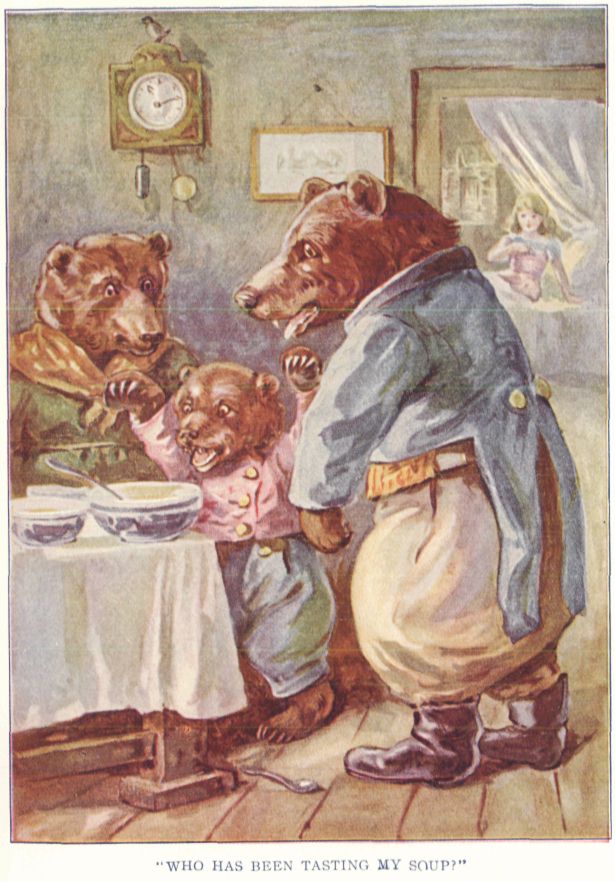
"The Story of the Three Bears", illustration from Childhood's Favorites and Fairy Stories

Berni is a brown bear mascot of the German football club Bayern Munich
Brown bears often figure into the literature of Europe and North America, in particular that which is written for children. "The Brown Bear of Norway" is a Scottish fairy tale telling the adventures of a girl who married a prince magically turned into a bear and who managed to get him back into a human form by the force of her love and after many trials and difficulties. With "Goldilocks and the Three Bears", a story from England, the Three Bears are usually depicted as brown bears. In German-speaking countries, children are often told the fairytale of "Snow White and Rose Red"; the handsome prince in this tale has been transfigured into a brown bear. In the United States, parents often read their preschool age children the book Brown Bear, Brown Bear, What Do You See? to teach them their colors and how they are associated with different animals.[477]
The Russian bear is a common national personification for Russia (as well as the former Soviet Union), despite the country having no appointed national animal. The brown bear is Finland's national animal.[478]
The grizzly bear is the state animal of Montana.[479] The California golden bear is the state animal of California.[480] Both animals are subspecies of the brown bear and the species was extirpated from the latter state.
The coat of arms of Madrid depicts a bear reaching up into a madroño or strawberry tree (Arbutus unedo) to eat some of its fruit, whereas the Swiss city of Bern's coat of arms also depicts a bear and the city's name is popularly thought to derive from the German word for bear. The brown bear is depicted on the reverse of the Croatian 5 kuna coin, minted since 1993.
The Bundesliga club Bayern Munich has a brown bear mascot named Berni. The National Football League (NFL) franchise in Chicago, Illinois, is named the Bears. In this context, no differentiation between American black and brown bears is needed. The school mascot for Bob Jones University, Brown University, George Fox University, the University of Alberta, the University of California, Berkeley, the University of California, Los Angeles, the University of California, Riverside, and numerous American high schools is the brown bear.
In the town of Prats de Molló, in Vallespir, southern France, a "bear festival" (festa de l'ós) is celebrated annually at the beginning of spring, in which the locals dress up as bears, cover themselves with soot or coal and oil and "attack" the onlookers, attempting to get everyone dirty. The festival ends with the ball de l'os (bear dance).
Legal status
The grizzly bear, sometimes called the silvertip bear, is listed as threatened in the contiguous United States. It is slowly repopulating in areas where it was previously extirpated, though it is still vulnerable.
The California grizzly bear (Ursus arctos californicus[481]) disappeared from the state of California in 1922, when the last one was shot in Tulare County. It is the official state animal.[480]
The Mexican grizzly bear is listed as an endangered species, but it may actually be extinct.
In Canada, it is listed as vulnerable in Alberta, British Columbia, the Northwest Territories and the Yukon Territory. Prairie populations of grizzly bear are listed as extirpated in Alberta, Manitoba and Saskatchewan.
The brown bear is a European Protected Species, given protection throughout the European Union.
See also
Cantabrian brown bear
List of fatal bear attacks in North America
Sankebetsu brown bear incident

